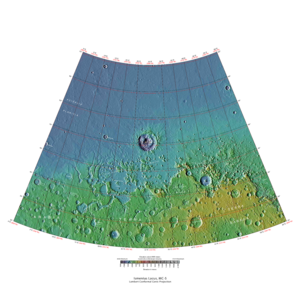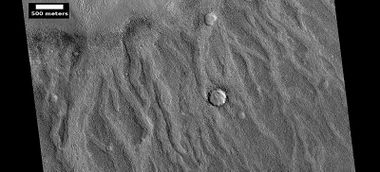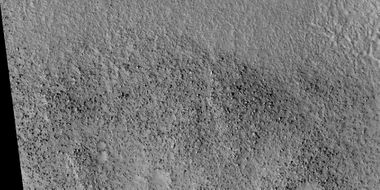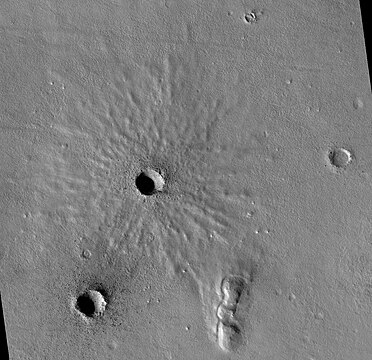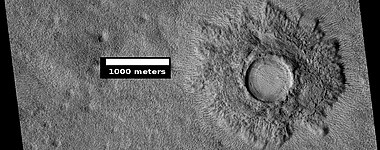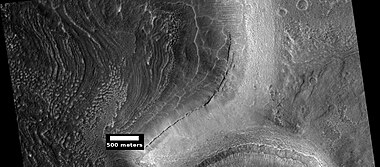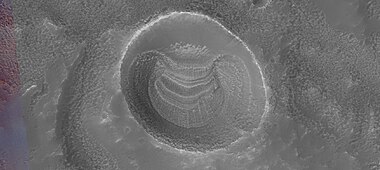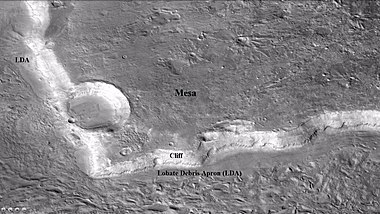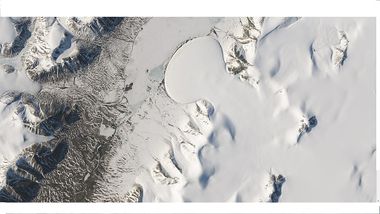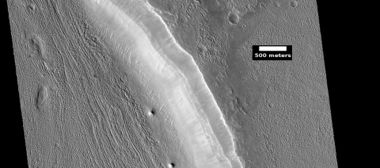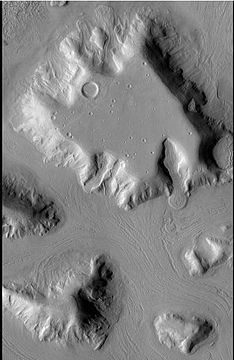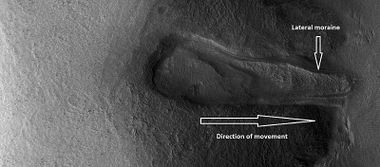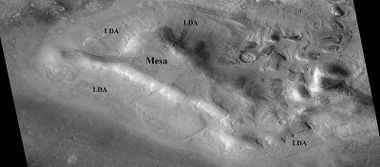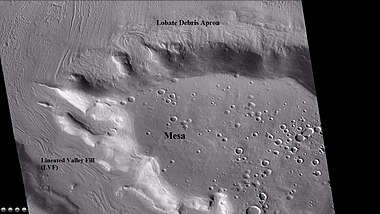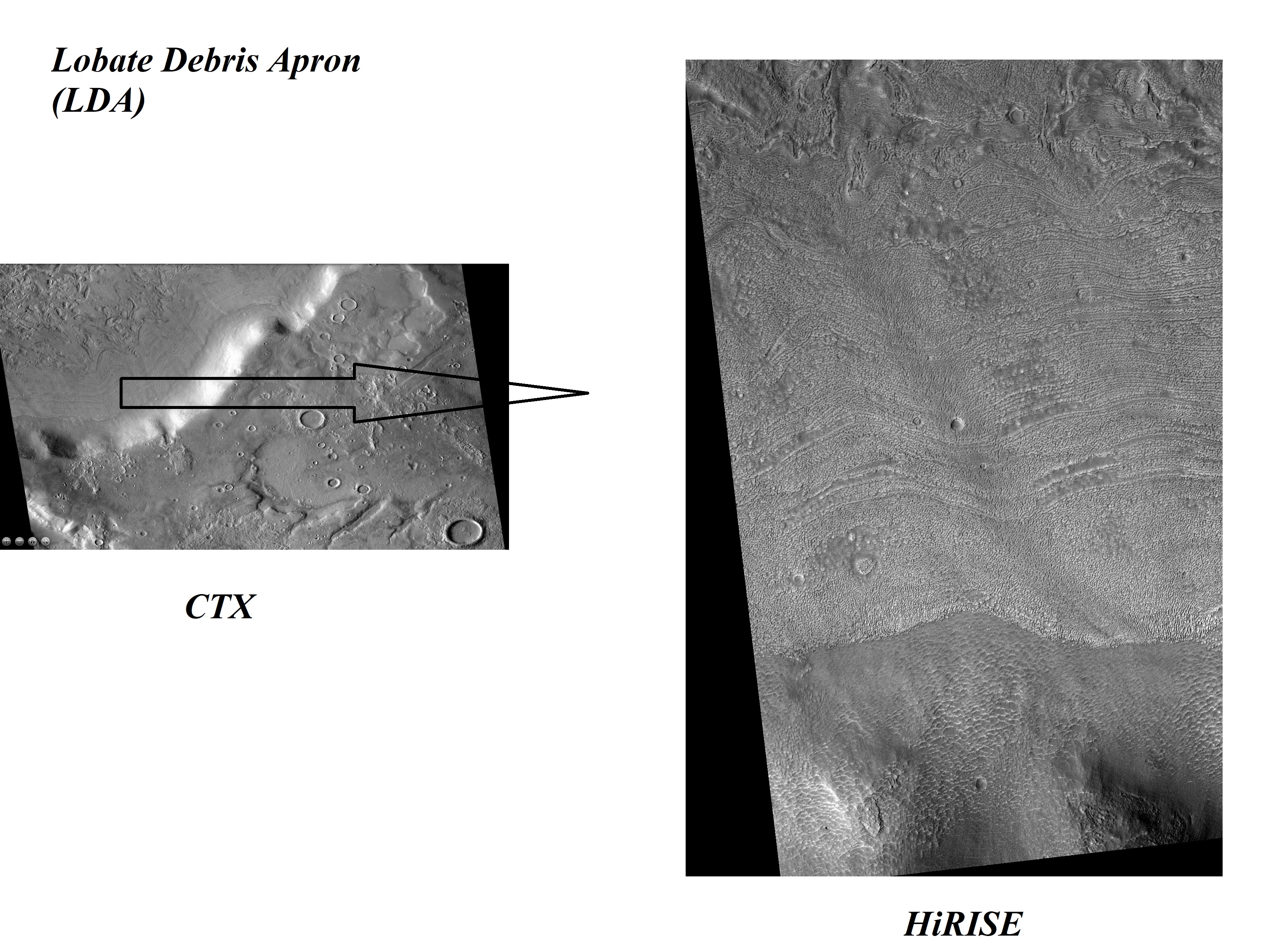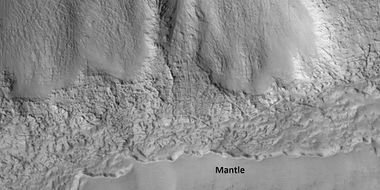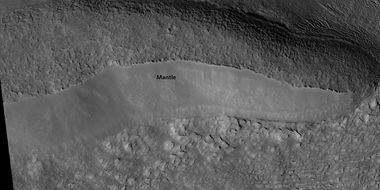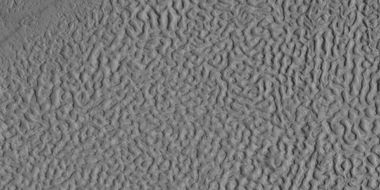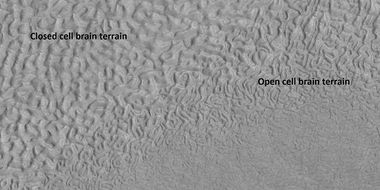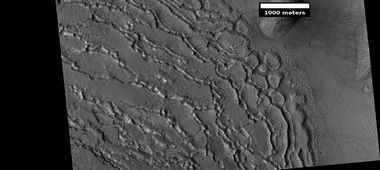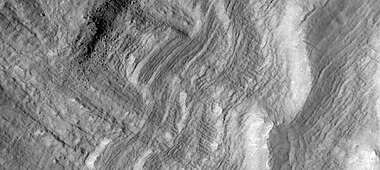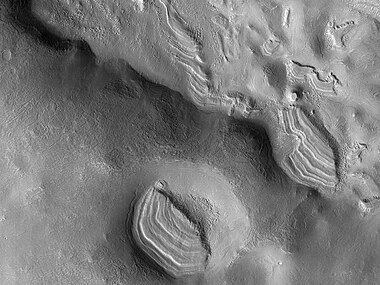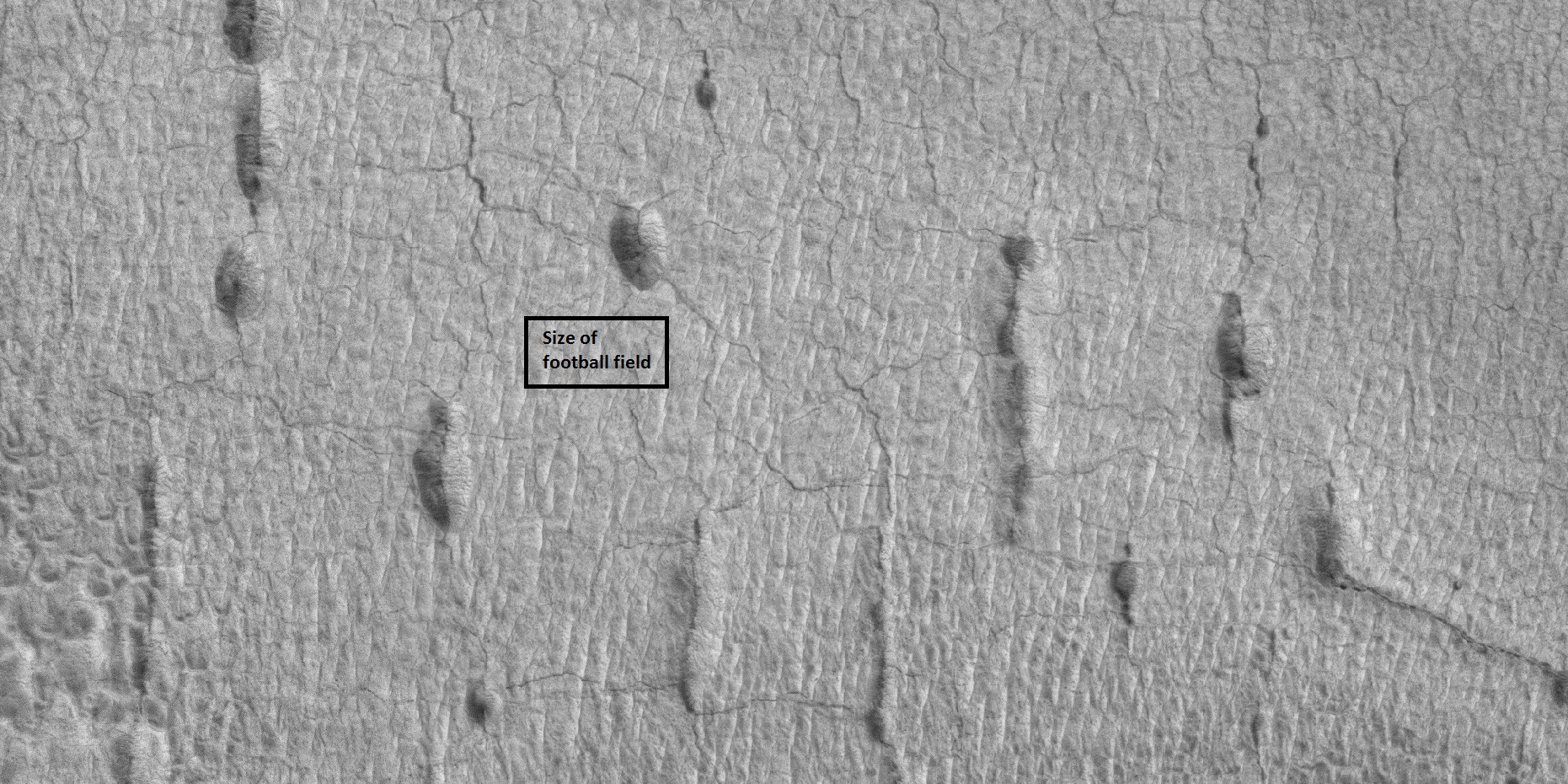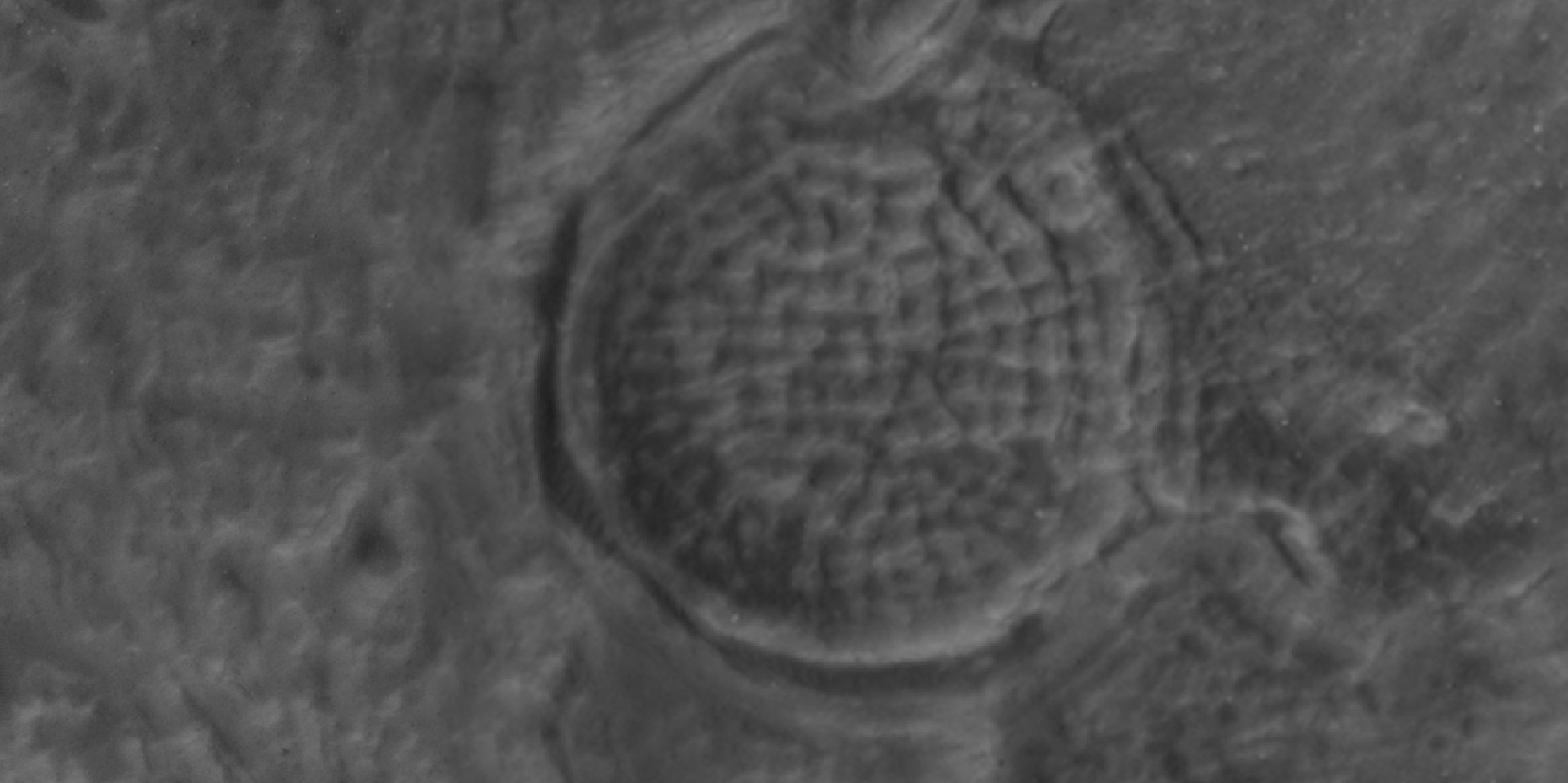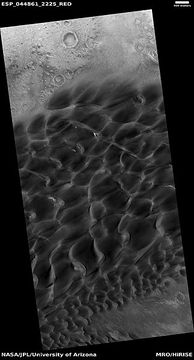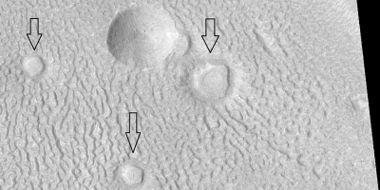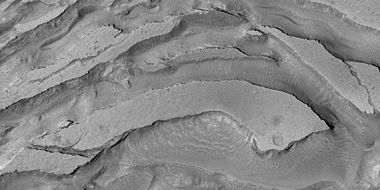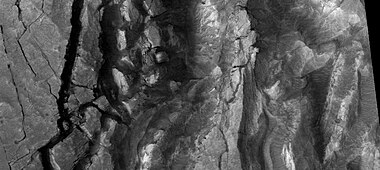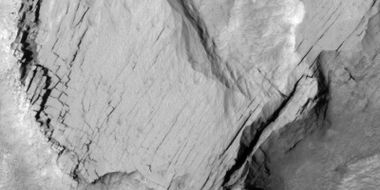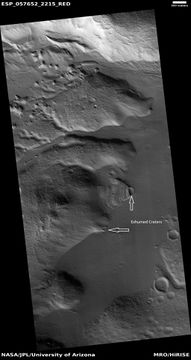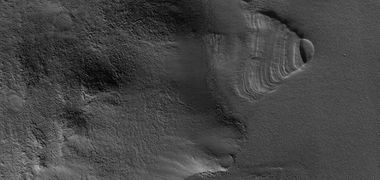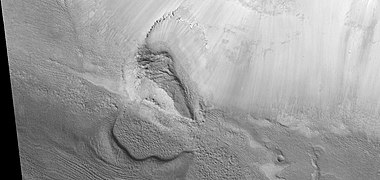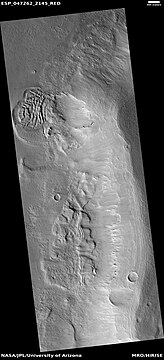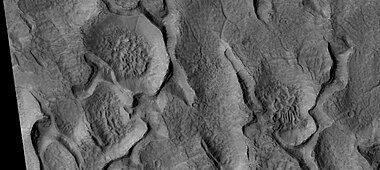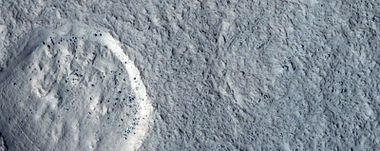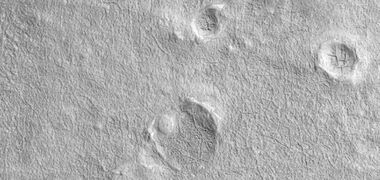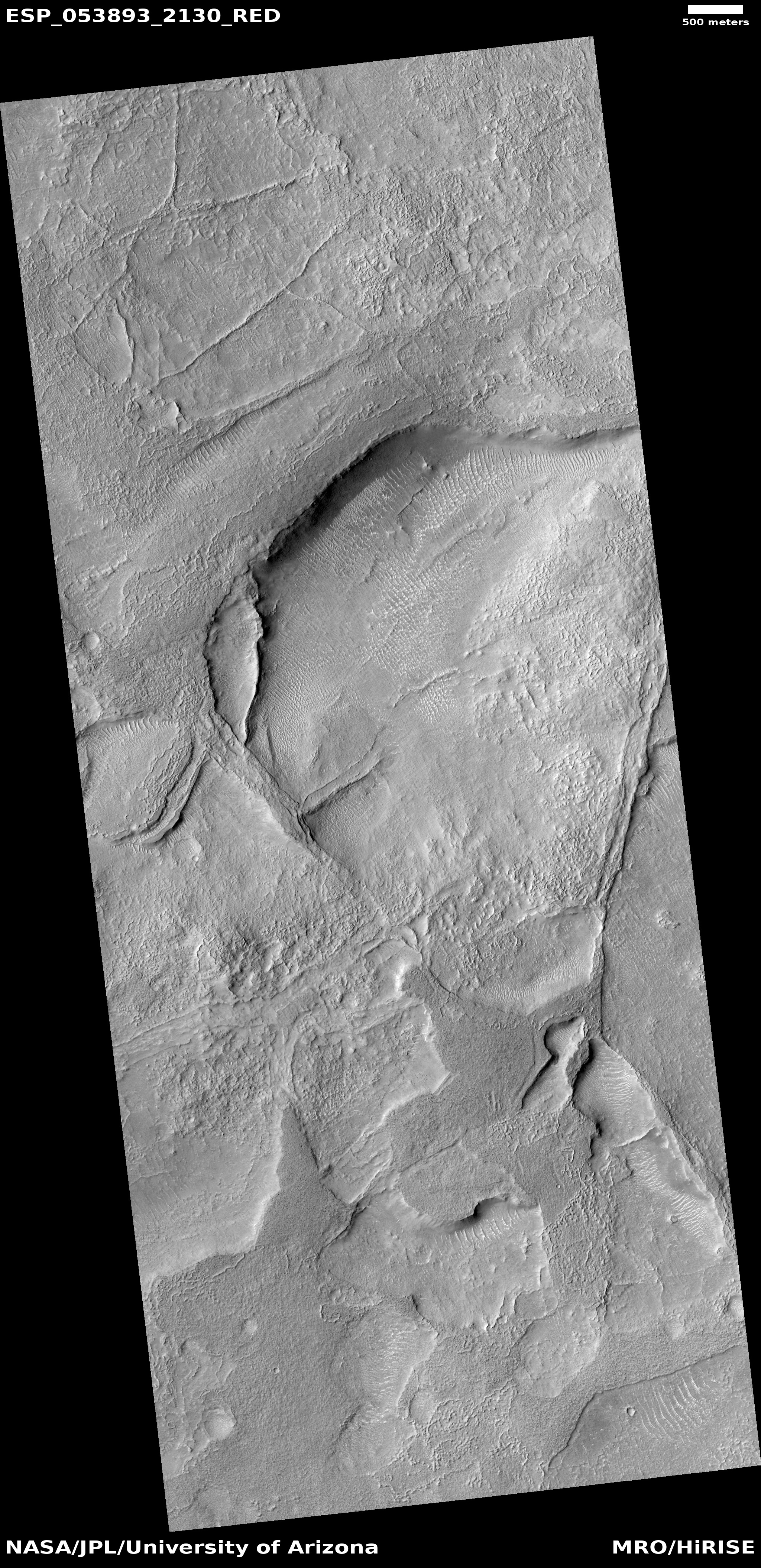Difference between revisions of "Ismenius Lacus quadrangle"
Suitupshowup (talk | contribs) (added image) |
|||
| (138 intermediate revisions by 2 users not shown) | |||
| Line 16: | Line 16: | ||
| − | This quadrangle has some of the most mysterious-looking landscapes on the planet. It truly looks like another world here. The Ismenius Lacus quadrangle contains regions called Deuteronilus Mensae and Protonilus Mensae, two places that are of special interest to scientists. They contain abundant evidence of present and past glacial activity. They also have a landscape unique to Mars, called Fretted terrain. The largest crater in the area is Lyot Crater, which contains channels probably carved by liquid water.<ref>Carter | first1 = J. | last2 = Poulet | first2 = F. | last3 = Bibring | first3 = J.-P. | last4 = Murchie | first4 = S. | year = 2010 | title = Detection of Hydrated Silicates in Crustal Outcrops in the Northern Plains of Mars | url = | journal = Science | volume = 328 | issue = 5986| pages = 1682–1686 | </ref> | + | [[File:Collage ismenius lacus 01.jpg|Typical features of Ismenius Lacus quadrangle, as seen by HiRISE under under HiWish program|600pxr| Typical features of Ismenius Lacus quadrangle]] |
| + | |||
| + | Typical features of Ismenius Lacus quadrangle | ||
| + | |||
| + | |||
| + | [[File:Collage ismenius lacus 02.jpg|More ypical features of Ismenius Lacus quadrangle, as seen by HiRISE under under HiWish program|600pxr| More typical features of Ismenius Lacus quadrangle]] | ||
| + | |||
| + | More typical features of Ismenius Lacus quadrangle | ||
| + | |||
| + | This quadrangle has some of the most mysterious-looking landscapes on the planet. It truly looks like another world here. Strong evidence of a past ocean on Mars exists in this region and is described below. The Ismenius Lacus quadrangle contains regions called Deuteronilus Mensae and Protonilus Mensae, two places that are of special interest to scientists. They contain abundant evidence of present and past glacial activity. They also have a landscape unique to Mars, called Fretted terrain. The largest crater in the area is Lyot Crater, which contains channels probably carved by liquid water.<ref>Carter | first1 = J. | last2 = Poulet | first2 = F. | last3 = Bibring | first3 = J.-P. | last4 = Murchie | first4 = S. | year = 2010 | title = Detection of Hydrated Silicates in Crustal Outcrops in the Northern Plains of Mars | url = | journal = Science | volume = 328 | issue = 5986| pages = 1682–1686 | </ref> | ||
| + | |||
The Ismenius Lacus quadrangle is located in the northern hemisphere and covers 30° to 65° north latitude and 300° to 360° west longitude (60° to 0° east longitude). The southern and northern borders of the Ismenius Lacus quadrangle are approximately 3065 km (1,905 mi) and 1500 km wide (930 mi) respectively. The north-to-south distance is about 2050 km (1,270 mi) (a bit less than the length of Greenland).<ref>Distances calculated using NASA World Wind measuring tool. http://worldwind.arc.nasa.gov/.</ref> The Ismenius Lacus quadrangle contains parts of regions named Acidalia Planitia, Arabia Terra, Vastitas Borealis, and Terra Sabaea.<ref>http://planetarynames.wr.usgs.gov/SearchResults?target=MARS&featureType=Terra,%20terrae</ref> | The Ismenius Lacus quadrangle is located in the northern hemisphere and covers 30° to 65° north latitude and 300° to 360° west longitude (60° to 0° east longitude). The southern and northern borders of the Ismenius Lacus quadrangle are approximately 3065 km (1,905 mi) and 1500 km wide (930 mi) respectively. The north-to-south distance is about 2050 km (1,270 mi) (a bit less than the length of Greenland).<ref>Distances calculated using NASA World Wind measuring tool. http://worldwind.arc.nasa.gov/.</ref> The Ismenius Lacus quadrangle contains parts of regions named Acidalia Planitia, Arabia Terra, Vastitas Borealis, and Terra Sabaea.<ref>http://planetarynames.wr.usgs.gov/SearchResults?target=MARS&featureType=Terra,%20terrae</ref> | ||
| + | |||
| + | In this article, some of the best pictures from a number of spacecraft will show what the landscape looks like in this region. The origins and significance of all features will be explained as they are currently understood. | ||
==Origin of names== | ==Origin of names== | ||
| − | Ismenius Lacus is the name of a classical albedo feature located at 40° N and 30° E on Mars. The term is Latin for Ismenian Lake, and refers to the Ismenian Spring near Thebes in Greece where Cadmus slew the guardian dragon. Cadmus was the legendary founder of Thebes, and had come to the spring to fetch water. The name was approved by the International Astronomical Union (IAU) in 1958.<ref>USGS Gazetteer of Planetary Nomenclature. Mars. http://planetarynames.wr.usgs.gov/.</ref> All names suggested for astronomical features have to eventually approved by the International Astronomical Union (IAU). | + | Ismenius Lacus is the name of a classical albedo feature located at 40° N and 30° E on Mars. Like most names for Martian places, Ismenius comes from old myths and stories. The term is Latin for Ismenian Lake, and refers to the Ismenian Spring near Thebes in Greece where Cadmus slew the guardian dragon. Cadmus was the legendary founder of Thebes, and had come to the spring to fetch water. The name was approved by the International Astronomical Union (IAU) in 1958.<ref>USGS Gazetteer of Planetary Nomenclature. Mars. http://planetarynames.wr.usgs.gov/.</ref> All names suggested for astronomical features have to eventually approved by the International Astronomical Union (IAU). |
| + | |||
Some important areas in this quadrangle derive from the names of canals that some early astronomers saw in this broad area. One such large canal they called Nilus. Since 1881–1882 it was split into other canals, some were called Nilosyrtis, Protonilus (first Nile),and Deuteronilus (second Nile).<ref>Blunck, J. 1982. Mars and its Satellites. Exposition Press. Smithtown, N.Y.</ref> | Some important areas in this quadrangle derive from the names of canals that some early astronomers saw in this broad area. One such large canal they called Nilus. Since 1881–1882 it was split into other canals, some were called Nilosyrtis, Protonilus (first Nile),and Deuteronilus (second Nile).<ref>Blunck, J. 1982. Mars and its Satellites. Exposition Press. Smithtown, N.Y.</ref> | ||
| + | ==Ocean== | ||
| − | + | [[File:ESP 054857 2270grooves.jpg|600pxr|Channels that may have been made by the backwash of tsunamis in an ocean Image is from HiRISE under the [[HiWish program]]]] | |
| + | |||
| + | Channels made by the backwash from tsunamis, tsunamis were probably caused by asteroids striking an ocean. Image is from HiRISE under the [[HiWish program]] | ||
| − | Many researchers have suggested that Mars once had a great ocean in the north.<ref>Parker | first1 = T. J. | last2 = Gorsline | first2 = D. S. | last3 = Saunders | first3 = R. S. | last4 = Pieri | first4 = D. C. | last5 = Schneeberger | first5 = D. M. | year = 1993 | title = Coastal geomorphology of the Martian northern plains | url = | journal = J. Geophys. Res. | volume = 98 | issue = E6| pages = 11061–11078 | doi=10.1029/93je00618 |</ref> <ref>Fairén | first1 = A. G. |display-authors=etal | year = 2003 | title = Episodic flood inundations of the northern plains of Mars | url = http://eprints.ucm.es/10431/1/9-Marte_3.pdf| journal = Icarus | volume = 165 | issue = 1| pages = 53–67 | </ref> <ref> Head | first1 = J. W. |display-authors=etal | year = 1999 | title = Possible ancient oceans on Mars: Evidence from Mars Orbiter Laser Altimeter data | url = | journal = Science | volume = 286 | issue = 5447| pages = 2134–2137 | doi=10.1126/science.286.5447.2134| pmid = 10591640 |</ref> <ref>Parker, T. J., Saunders, R. S. & Schneeberger, D. M. Transitional morphology in west Deuteronilus Mensae, Mars: Implications for modification of the lowland/upland boundary" ''Icarus'' 1989; 82, 111–145</ref> <ref>Carr | first1 = M. H. | last2 = Head | first2 = J. W. | year = 2003 | title = Oceans on Mars: An assessment of the observational evidence and possible fate | url = | journal = J. Geophys. Res. | volume = 108 | issue = E5| page = 5042 |</ref> <ref>Kreslavsky | first1 = M. A. | last2 = Head | first2 = J. W. | year = 2002| title = Fate of outflow channel effluent in the northern lowlands of Mars: The Vastitas Borealis Formation as a sublimation residue from frozen ponded bodies of water | url = | journal = J. Geophys. Res. | volume = 107 | issue = E12| page = 5121 |</ref> <ref>Clifford, S. M. & Parker, T. J. The evolution of the martian hydrosphere: Implications for the fate of a primordial ocean and the current state of the northern plains" ''Icarus'' 2001; 154, 40–79</ref> Much evidence for this ocean has been gathered over several decades. New evidence was published in May 2016. A large team of scientists described how some of the surface in Ismenius Lacus quadrangle was altered by two tsunamis. The tsunamis were caused by asteroids striking the ocean. Both were thought to have been strong enough to create 30 km diameter craters. The first tsunami picked up and carried boulders the size of cars or small houses. The backwash from the wave formed channels by rearranging the boulders. The second came in when the ocean was 300 m lower. The second carried a great deal of ice which was dropped in valleys. Calculations show that the average height of the waves would have been 50 m, but the heights would vary from 10 | + | Many researchers have suggested that Mars once had a great ocean in the north.<ref>Parker | first1 = T. J. | last2 = Gorsline | first2 = D. S. | last3 = Saunders | first3 = R. S. | last4 = Pieri | first4 = D. C. | last5 = Schneeberger | first5 = D. M. | year = 1993 | title = Coastal geomorphology of the Martian northern plains | url = | journal = J. Geophys. Res. | volume = 98 | issue = E6| pages = 11061–11078 | doi=10.1029/93je00618 |</ref> <ref>Fairén | first1 = A. G. |display-authors=etal | year = 2003 | title = Episodic flood inundations of the northern plains of Mars | url = http://eprints.ucm.es/10431/1/9-Marte_3.pdf| journal = Icarus | volume = 165 | issue = 1| pages = 53–67 | </ref> <ref> Head | first1 = J. W. |display-authors=etal | year = 1999 | title = Possible ancient oceans on Mars: Evidence from Mars Orbiter Laser Altimeter data | url = | journal = Science | volume = 286 | issue = 5447| pages = 2134–2137 | doi=10.1126/science.286.5447.2134| pmid = 10591640 |</ref> <ref>Parker, T. J., Saunders, R. S. & Schneeberger, D. M. Transitional morphology in west Deuteronilus Mensae, Mars: Implications for modification of the lowland/upland boundary" ''Icarus'' 1989; 82, 111–145</ref> <ref>Carr | first1 = M. H. | last2 = Head | first2 = J. W. | year = 2003 | title = Oceans on Mars: An assessment of the observational evidence and possible fate | url = | journal = J. Geophys. Res. | volume = 108 | issue = E5| page = 5042 |</ref> <ref>Kreslavsky | first1 = M. A. | last2 = Head | first2 = J. W. | year = 2002| title = Fate of outflow channel effluent in the northern lowlands of Mars: The Vastitas Borealis Formation as a sublimation residue from frozen ponded bodies of water | url = | journal = J. Geophys. Res. | volume = 107 | issue = E12| page = 5121 |</ref> <ref>Clifford, S. M. & Parker, T. J. The evolution of the martian hydrosphere: Implications for the fate of a primordial ocean and the current state of the northern plains" ''Icarus'' 2001; 154, 40–79</ref> Much evidence for this ocean has been gathered over several decades. New evidence was published in May 2016. A large team of scientists described how some of the surface in Ismenius Lacus quadrangle was altered by two tsunamis. The tsunamis were caused by asteroids striking the ocean. Both were thought to have been strong enough to create 30 km diameter craters. The first tsunami picked up and carried boulders the size of cars or small houses. The backwash from the wave formed channels by rearranging the boulders. The second came in when the ocean was 300 m lower. The second carried a great deal of ice which was dropped in valleys. Calculations show that the average height of the waves would have been 50 m, but the heights would vary from 10 to 120 meters. So, some large waves would have gone over a 36 story building.<ref>https://www.convertunits.com/from/metre/to/story</ref> Numerical simulations show that in this particular part of the ocean two 30 km in diameter would form every 30 million years. The implication here is that a great northern ocean may have existed for millions of years. One argument against an ocean has been the lack of shoreline features. These features may have been washed away by these tsunami events. The parts of Mars studied in this research are Chryse Planitia and northwestern Arabia Terra. These tsunamis affected some surfaces in the Ismenius Lacus quadrangle and in the [[Mare Acidalium quadrangle]].<ref>Ancient Tsunami Evidence on Mars Reveals Life Potential |date=May 20, 2016 |url=http://astrobiology.com/2016/05/ancient-tsunami-evidence-on-mars-reveals-life-potential.html</ref> <ref>Rodriguez | first1 = J. |display-authors=etal | year = 2016 | title = Tsunami waves extensively resurfaced the shorelines of an early Martian ocean | url = | journal = Scientific Reports | volume = 6 | issue = | page = 25106 | doi=10.1038/srep25106| pmid = 27196957 | pmc = 4872529 |</ref> <ref>| doi=10.1038/srep25106| pmid=27196957| pmc=4872529| title=Tsunami waves extensively resurfaced the shorelines of an early Martian ocean| journal=Scientific Reports| volume=6| pages=25106| year=2016| last1=Rodriguez| first1=J. Alexis P.| last2=Fairén| first2=Alberto G.| last3=Tanaka| first3=Kenneth L.| last4=Zarroca| first4=Mario| last5=Linares| first5=Rogelio| last6=Platz| first6=Thomas| last7=Komatsu| first7=Goro| last8=Miyamoto| first8=Hideaki| last9=Kargel| first9=Jeffrey S.| last10=Yan| first10=Jianguo| last11=Gulick| first11=Virginia| last12=Higuchi| first12=Kana| last13=Baker| first13=Victor R.| last14=Glines| first14=Natalie</ref> <ref>Cornell University. "Ancient tsunami evidence on Mars reveals life potential." ScienceDaily. ScienceDaily, 19 May 2016. https://www.sciencedaily.com/releases/2016/05/160519101756.htm.</ref> |
<gallery class="center" widths="380px" heights="360px"> | <gallery class="center" widths="380px" heights="360px"> | ||
| − | ESP 028537 2270tsunamischannels.jpg|Channels made by the backwash from tsunamis, | + | ESP 028537 2270tsunamischannels.jpg|Channels made by the backwash from tsunamis, Tsunamis were probably caused by asteroids striking the ocean. |
| − | + | ||
File:ESP 055714 2270tsunamibackwash.jpg|Possible backwash channels that may have been created by a tsunami, as seen by HiRISE under HiWish program | File:ESP 055714 2270tsunamibackwash.jpg|Possible backwash channels that may have been created by a tsunami, as seen by HiRISE under HiWish program | ||
| − | 28537 2270tsunamisboulders.jpg|Boulders that were picked up, carried, and dropped by tsunamis | + | 28537 2270tsunamisboulders.jpg|Boulders that were picked up, carried, and dropped by tsunamis Tsunamis were probably caused by asteroids striking ocean. Boulders in picture are between the size of cars and houses. |
| − | Tsunamisstreamlinedp20008931.jpg|Streamlined promontory eroded by tsunami | + | Tsunamisstreamlinedp20008931.jpg|Streamlined promontory eroded by tsunami Tsunamis were probably caused by asteroids striking ocean. |
File:ESP 054989 2270curvedbands.jpg|Concentric bands that may have been produced by the waves of a tsunami. Image is from HiRISE under the HiWish program. | File:ESP 054989 2270curvedbands.jpg|Concentric bands that may have been produced by the waves of a tsunami. Image is from HiRISE under the HiWish program. | ||
| Line 43: | Line 59: | ||
==Channels (Rivers)== | ==Channels (Rivers)== | ||
| + | |||
| + | [[File:ESP 043623 2160meander.jpg|600pxr|Meanders Meanders are commonly formed in old river systems when the water is moving slowly.]] | ||
| + | Meanders They are formed in old river systems when the water is moving slowly. | ||
Many features were probably rivers with water flowing in them billions of years ago. Pictures below show many channels and parts of channels. | Many features were probably rivers with water flowing in them billions of years ago. Pictures below show many channels and parts of channels. | ||
| Line 58: | Line 77: | ||
</gallery> | </gallery> | ||
| − | Some places (like below) display a smaller channel within a larger, wider channel or valley. When this occurs it means water went through the region at least two times in the past. This implies that water was not here once for | + | Some places (like below) display a smaller channel within a larger, wider channel or valley. When this occurs it means water went through the region at least two times in the past. This implies that water was not just here once for a short period of time. |
<gallery class="center" widths="380px" heights="360px"> | <gallery class="center" widths="380px" heights="360px"> | ||
| Line 79: | Line 98: | ||
ESP 042502 2200channels.jpg|Channels | ESP 042502 2200channels.jpg|Channels | ||
| − | |||
| − | |||
ESP 045837 2245channels.jpg|Wide view of channels | ESP 045837 2245channels.jpg|Wide view of channels | ||
| Line 104: | Line 121: | ||
ESP 046458 2160channel.jpg|Channel | ESP 046458 2160channel.jpg|Channel | ||
ESP 050914 2130channel.jpg|Channels | ESP 050914 2130channel.jpg|Channels | ||
| + | |||
| + | File:Stream leading to lake and other channels 02.jpg|Channels with one leading to a lake This image was named HiRISE picture of the day. | ||
| + | File:Stream leading to lake 01.jpg|Old stream bed attached to low area that was probably a lake. | ||
ESP 052761 2170channel.jpg|Channels, as seen by HiRISE under HiWish program | ESP 052761 2170channel.jpg|Channels, as seen by HiRISE under HiWish program | ||
| Line 115: | Line 135: | ||
<gallery class="center" widths="380px" heights="360px"> | <gallery class="center" widths="380px" heights="360px"> | ||
| + | File:Channels, as seen by HiRISE.jpg|Channels, as seen by HiRISE under HiWish program | ||
| + | File:Close view of a channel.jpg|Close view of channel, as seen by HiRISE | ||
| − | File:ESP | + | File:ESP 057627 2175channelssapping.jpg|Channels The ends of the channels have shapes that suggest they were formed by the process of sapping. |
| − | File:ESP | + | File:ESP 057139 2140channels.jpg|Channels These channels are in the ejecta of a crater; hence, they may have formed from warm ejecta melting ground ice. |
| + | File:ESP 045867 2150channels.jpg|Close vies of channel with scale | ||
| + | File:ESP 057560 2180channel.jpg|Channel near ejecta | ||
| − | |||
| − | File:ESP | + | </gallery> |
| + | |||
| + | |||
| + | [[File:ESP 056689 2210channelslowspot.jpg|600pxr|Channels that empty into a low area that could have been a lake, as seen by HiRISE under HiWish program]] | ||
| − | + | Channels that empty into a possible lake, as seen by HiRISE under [[HiWish program]] | |
== Lyot Crater == | == Lyot Crater == | ||
| Line 130: | Line 156: | ||
The vast northern plains of Mars are generally flat and smooth with few craters. However, a few large craters do stand out. The giant impact crater, Lyot, is easy to see in the northern part of Ismenius Lacus. There are only a very few craters along the far northern latitudes.<ref>U.S. department of the Interior U.S. Geological Survey, Topographic Map of the Eastern Region of Mars M 15M 0/270 2AT, 1991</ref> Lyot Crater is the deepest point in Mars's northern hemisphere.<ref>http://space.com/scienceastronomy/090514--mars-rivers.html</ref> One image below of Lyot Crater Dunes shows a variety of interesting forms: dark dunes, light-toned deposits, and Dust Devil Tracks. Dust devils, which resemble miniature tornados, create tracks by removing a thin, but bright deposit of dust to reveal the darker underlying surface. It does not take too much fine dust to cover those tracks--experiments in Earth laboratories demonstrate that only a few 10's of microns of dust will do the trick. Note on units: a micron is an older name for micrometre or micrometer. The width of a single human hair ranges from approximately 20 to 200 microns (μm); hence, the dust that can cover dust devil tracks may only be the thickness of a human hair.<ref>https://en.wikipedia.org/wiki/Micrometre</ref> Light-toned materials are an important find because they are widely believed to contain minerals formed in water. Research, published in June 2010, described evidence for liquid water in Lyot crater in the past. | The vast northern plains of Mars are generally flat and smooth with few craters. However, a few large craters do stand out. The giant impact crater, Lyot, is easy to see in the northern part of Ismenius Lacus. There are only a very few craters along the far northern latitudes.<ref>U.S. department of the Interior U.S. Geological Survey, Topographic Map of the Eastern Region of Mars M 15M 0/270 2AT, 1991</ref> Lyot Crater is the deepest point in Mars's northern hemisphere.<ref>http://space.com/scienceastronomy/090514--mars-rivers.html</ref> One image below of Lyot Crater Dunes shows a variety of interesting forms: dark dunes, light-toned deposits, and Dust Devil Tracks. Dust devils, which resemble miniature tornados, create tracks by removing a thin, but bright deposit of dust to reveal the darker underlying surface. It does not take too much fine dust to cover those tracks--experiments in Earth laboratories demonstrate that only a few 10's of microns of dust will do the trick. Note on units: a micron is an older name for micrometre or micrometer. The width of a single human hair ranges from approximately 20 to 200 microns (μm); hence, the dust that can cover dust devil tracks may only be the thickness of a human hair.<ref>https://en.wikipedia.org/wiki/Micrometre</ref> Light-toned materials are an important find because they are widely believed to contain minerals formed in water. Research, published in June 2010, described evidence for liquid water in Lyot crater in the past. | ||
| − | Many channels have been found near Lyot Crater. Research, published in 2017, concluded that the channels were made from water released when the hot ejecta landed on a layer of ice that was 20 to 300 meters thick. Calculations suggest that the ejecta would have had a temperature of at least 250 degrees Fahrenheit. The valleys seem to start from beneath the ejecta near the outer edge of the ejecta. The existence of these channels is unusual because although Mars used to have water in rivers, lakes, and an ocean | + | Many channels have been found near Lyot Crater. Research, published in 2017, concluded that the channels were made from water released when the hot ejecta landed on a layer of ice that was 20 to 300 meters thick. Calculations suggest that the ejecta would have had a temperature of at least 250 degrees Fahrenheit. The valleys seem to start from beneath the ejecta near the outer edge of the ejecta. The existence of these channels is unusual because although Mars used to have water in rivers, lakes, and an ocean; channels in Lyot came after we had thought that Mars had dried up. So Mars had flowing water later then we believed.<ref>doi=10.1002/2017GL073821 | volume=44 | issue=11 | title=Extensive Amazonian-aged fluvial channels on Mars: Evaluating the role of Lyot crater in their formation | journal=Geophysical Research Letters | pages=5336–5344 | last1 = Weiss | first1 = David K.| </ref> <ref>Weiss, D., et al. 2017. Extensive Amazonian-aged fluvial channels on Mars: Evaluating the role of Lyot crater in their formation. Geophysical Research Letters: 44, doi:10.1002/2017GL073821.</ref> <ref>http://spaceref.com/mars/hot-rocks-led-to-relatively-recent-water-carved-valleys-on-mars.html</ref> |
| + | |||
| + | [[File: ESP 045389 2295lyotchannels.jpg|600pxr|Wide view of channels in Lyot Crater, as seen by HiRISE under [[HiWish program]]]] | ||
| + | Wide view of channels in Lyot Crater, as seen by HiRISE under [[HiWish program]] | ||
<gallery class="center" widths="380px" heights="360px"> | <gallery class="center" widths="380px" heights="360px"> | ||
| − | + | ||
ESP 045389 2295lyotchannelstop.jpg|Close view of channels in Lyot Crater | ESP 045389 2295lyotchannelstop.jpg|Close view of channels in Lyot Crater | ||
ESP 045389 2295lyotchannelsbottom.jpg|Close view of channels in Lyot Crater, as seen by HiRISE under HiWish program | ESP 045389 2295lyotchannelsbottom.jpg|Close view of channels in Lyot Crater, as seen by HiRISE under HiWish program | ||
| Line 146: | Line 175: | ||
==Other craters== | ==Other craters== | ||
| − | Impact craters generally have a rim with ejecta around them; in contrast volcanic craters usually do not have a rim or ejecta deposits. As craters get larger (greater than 10 km in diameter), they usually have a central peak.<ref>http://www.lpi.usra.edu/publications/slidesets/stones/</ref> The peak is caused by a rebound of the crater floor following the impact.<ref | + | Impact craters generally have a rim with ejecta around them; in contrast volcanic craters usually do not have a rim or ejecta deposits. As craters get larger (greater than 10 km in diameter), they usually have a central peak.<ref>http://www.lpi.usra.edu/publications/slidesets/stones/</ref> The peak is caused by a rebound of the crater floor following the impact.<ref>Hugh H. Kieffer|title=Mars|url=https://books.google.com/books?id=NoDvAAAAMAAJ|accessdate=7 March 2011|date=1992|publisher=University of Arizona Press|isbn=978-0-8165-1257-7}}</ref> Sometimes craters will display layers in their walls. Since the collision that produces a crater is like a powerful explosion, rocks from deep underground are tossed unto the surface. Hence, craters are useful for showing us what lies deep under the surface. |
<gallery class="center" widths="380px" heights="360px"> | <gallery class="center" widths="380px" heights="360px"> | ||
| − | + | File:Fresh crater ESP 64497 2250.jpg|Fresh crater This image was named HiRISE picture of the day. | |
File:ESP 057007 2190freshcrater.jpg|Fresh crater, as seen by HiRISE under HiWish program This is a young crater because one can easily see the rim and ejecta. They have not yet been eroded. | File:ESP 057007 2190freshcrater.jpg|Fresh crater, as seen by HiRISE under HiWish program This is a young crater because one can easily see the rim and ejecta. They have not yet been eroded. | ||
| Line 155: | Line 184: | ||
File:ESP 054963 1950craterbench.jpg|Crater with a bench A crater with a bench may be formed from settling of the crater wall or it may be due to impact into something with vastly different types of layers. | File:ESP 054963 1950craterbench.jpg|Crater with a bench A crater with a bench may be formed from settling of the crater wall or it may be due to impact into something with vastly different types of layers. | ||
| + | |||
| + | File:ESP 066174 2110doublecrater.jpg|Double crater. Box indicates the size of a football field in this scene. This image was named HiRISE picture of the day. | ||
File:ESP 056953 2160expandedcraters.jpg|Possible expanded secondary craters, as seen by HiRISE under [[HiWish program]] These craters may have become much wider, as ice left the ground around the rims.<ref>http://www.uahirise.org/epo/nuggets/expanded-secondary.pdf</ref> <ref>Viola, D., et al. 2014. EXPANDED CRATERS IN ARCADIA PLANITIA: EVIDENCE FOR >20 MYR OLD SUBSURFACE ICE. Eighth International Conference on Mars (2014). 1022pdf.</ref> | File:ESP 056953 2160expandedcraters.jpg|Possible expanded secondary craters, as seen by HiRISE under [[HiWish program]] These craters may have become much wider, as ice left the ground around the rims.<ref>http://www.uahirise.org/epo/nuggets/expanded-secondary.pdf</ref> <ref>Viola, D., et al. 2014. EXPANDED CRATERS IN ARCADIA PLANITIA: EVIDENCE FOR >20 MYR OLD SUBSURFACE ICE. Eighth International Conference on Mars (2014). 1022pdf.</ref> | ||
| Line 170: | Line 201: | ||
<gallery class="center" widths="380px" heights="360px"> | <gallery class="center" widths="380px" heights="360px"> | ||
| − | Image:Cerulli Crater.jpg|Cerulli Crater | + | Image:Cerulli Crater.jpg|Cerulli Crater It looks like a delta was formed as channels bought in debris and dumped then in a lake that was in the crater. |
| − | |||
ESP 044506 2245layers.jpg|Group of layers in crater | ESP 044506 2245layers.jpg|Group of layers in crater | ||
| + | File:ESP 076130 2165craterdepositswide 01.jpg|Wide view of craters with strange deposits, as seen by HiRISE under HiWish program | ||
| + | File:Close view of strange crater deposit 02.jpg|Close view of crater with strange, layered deposit, as seen by HiRISE | ||
| + | File:Close view of strange crater deposit with layers 03.jpg|close view of crater with strange layered deposit | ||
| + | File:Crater with mesa ESP 074745 2105.jpg|Crater with mesa. First the crater was formed. Later material was deposited in the area. That material was eroded all over, except in this crater. This image was named HiRISE picture of the day for January 18, 2024. | ||
| + | |||
</gallery> | </gallery> | ||
| + | |||
| + | [[File: Wikiquenissetglaciers.jpg|600pxr|Northeast rim of Quenisset Crater, as seen by CTX camera (on Mars Reconnaissance Orbiter). Arrows indicate old glaciers.]] | ||
| + | |Northeast rim of Quenisset Crater, as seen by CTX camera (on Mars Reconnaissance Orbiter). Arrows indicate old glaciers. | ||
== Deltas == | == Deltas == | ||
| Line 188: | Line 226: | ||
== Fretted terrain == | == Fretted terrain == | ||
| − | The Ismenius Lacus quadrangle contains several interesting features such as fretted terrain, parts of which are found in Deuteronilus Mensae and Protonilus Mensae. Fretted terrain contains smooth, flat lowlands along with steep cliffs. The scarps or cliffs are usually 1 to 2 km high. Channels in the area have wide, flat floors and steep walls. Many buttes and mesas are present. In fretted terrain the land seems to transition from narrow straight valleys to isolated mesas.<ref>Sharp, R. 1973. Mars Fretted and chaotic terrains. J. Geophys. Res.: 78. 4073–4083</ref> Most of the mesas are surrounded by forms that have been called a variety of names: circum-mesa aprons, debris aprons, rock glaciers, and lobate debris apron (LDA)s. The flat floors here often display many lines or lineations that scientists call lineated valley fill (LVF). These are | + | The Ismenius Lacus quadrangle contains several interesting features such as fretted terrain, parts of which are found in Deuteronilus Mensae and Protonilus Mensae. Fretted terrain contains smooth, flat lowlands along with steep cliffs. The scarps or cliffs are usually 1 to 2 km high. Channels in the area have wide, flat floors and steep walls. Many buttes and mesas are present. In fretted terrain the land seems to transition from narrow straight valleys to isolated mesas.<ref>Sharp, R. 1973. Mars Fretted and chaotic terrains. J. Geophys. Res.: 78. 4073–4083</ref> Most of the mesas are surrounded by forms that have been called a variety of names: circum-mesa aprons, debris aprons, rock glaciers, and lobate debris apron (LDA)s. The flat floors here often display many lines or lineations that scientists call lineated valley fill (LVF). These are caused by glacier-like flow. <ref>http://www.lpi.usra.edu/meetings/lpsc2000/pdf/1053.pdf</ref> At first they appeared to resemble rock glaciers on Earth. But scientists could not be sure. Even after the Mars Global Surveyor (MGS) Mars Orbiter Camera (MOC) took a variety of pictures of fretted terrain, experts could not tell for sure if material was moving or flowing as it would in an ice-rich deposit (glacier). Eventually, proof of their true nature was discovered by radar studies with the [[Mars Reconnaissance Orbiter]] showed that they contain pure water ice covered with a thin layer of rocks that insulated the ice.<ref>Plaut, J. et al. 2008. Radar Evidence for Ice in Lobate Debris Aprons in the Mid-Northern Latitudes of Mars. Lunar and Planetary Science XXXIX. 2290.pdf</ref> <ref>Plaut | first1 = J. | last2 = Safaeinili | first2 = A. | last3 = Holt | first3 = J. | last4 = Phillips | first4 = R. | last5 = Head | first5 = J. | last6 = Seu | first6 = R. | last7 = Putzig | first7 = N. | last8 = Frigeri | first8 = A. | year = 2009 | title = Radar evidence for ice in lobate debris aprons in the midnorthern latitudes of Mars | url = https://semanticscholar.org/paper/f6b94761e6a276ce6894374ae9bea88fdc3e5e19| journal = Geophys. Res. Lett. | volume = 36| issue = 2| pages = n/a |</ref> |
<gallery class="center" widths="380px" heights="360px"> | <gallery class="center" widths="380px" heights="360px"> | ||
| − | Image:Fretted terrain of Ismenius Lacus taken with MGS.JPG|Fretted terrain of Ismenius Lacus showing flat floored valleys and cliffs. Photo taken with Mars Orbiter Camera (MOC)on the [[Mars Global Surveyor]], under the MOC Public Targeting Program. The white rectangle indicates the position of a high resolution image. | + | Image:Fretted terrain of Ismenius Lacus taken with MGS.JPG|Fretted terrain of Ismenius Lacus showing flat floored valleys and cliffs. Photo taken with Mars Orbiter Camera (MOC) on the [[Mars Global Surveyor]], under the MOC Public Targeting Program. The white rectangle indicates the position of a high resolution image. |
Image:Steep cliff in Ismenius Lacus taken with MGS.JPG|Enlargement of the photo on the left showing cliff. Photo taken with high-resolution camera of Mars Global Surveyor (MGS), under the MOC Public Targeting Program. | Image:Steep cliff in Ismenius Lacus taken with MGS.JPG|Enlargement of the photo on the left showing cliff. Photo taken with high-resolution camera of Mars Global Surveyor (MGS), under the MOC Public Targeting Program. | ||
| − | Wikictxp13clifflda.jpg|Wide view of mesa with CTX showing cliff face and location of lobate debris apron (LDA) | + | Wikictxp13clifflda.jpg|Wide view of mesa with CTX showing cliff face and location of lobate debris apron (LDA). |
| − | Wikifretesp 028313 2220cliff.jpg|Enlargement of previous CTX image of mesa. This image shows the cliff face and detail in the LDA. Image taken with HiRISE under HiWish program | + | Wikifretesp 028313 2220cliff.jpg|Enlargement of previous CTX image of mesa. This image shows the cliff face and detail in the LDA. Image taken with HiRISE under HiWish program. |
| − | |||
| − | |||
| − | + | WikiESP 020769 2225fretted.jpg|Close-up of lineated valley fill (LVF) Note: this is an enlargement of the previous CTX image. | |
| + | File:ESP 057020 2180fretterrain.jpg|Example of frettered terrain Fretted terrain contains many wide, flat-floored valleys. | ||
| + | File:ESP 084779 2170 flatfloor channel.jpg|Flat-floored channelin fretted terain, as seen by HiRISE under HiWish program | ||
</gallery> | </gallery> | ||
| + | |||
| + | [[File: Wikifrettedctxp22.jpg|600pxr|Wide CTX view showing mesa and buttes with lobate debris aprons and lineated valley fill around them. ]] | ||
| + | Wide CTX view showing mesa and buttes with lobate debris aprons and lineated valley fill around them. These are typical features of fretted terrain | ||
== Glaciers == | == Glaciers == | ||
| + | |||
| + | [[File: ESP 052127 2225flow.jpg|600pxr|Flow, as seen by HiRISE under HiWish program]] | ||
| + | Glacier, as seen by HiRISE under HiWish program | ||
The Ismenius Lacus quadrangle might well be called the land of glaciers. Glaciers formed much of the observable surface in large areas of Mars. Much of the area in high latitudes, especially the Ismenius Lacus quadrangle, is believed to still contain enormous amounts of water ice.<ref>Hugh H. Kieffer (1992). Mars. University of Arizona Press. ISBN 978-0-8165-1257-7</ref> <ref> Plaut, J. et al. 2008. Radar Evidence for Ice in Lobate Debris Aprons in the Mid-Northern Latitudes of Mars. Lunar and Planetary Science XXXIX. 2290.pdf</ref> <ref>http://www.esa.int/SPECIALS/Mars_Express/SEMBS5V681F_0.html</ref> In March 2010, scientists released the results of a radar study of an area called Deuteronilus Mensae that found widespread evidence of ice lying beneath a few meters of rock debris.<ref>http://news.discovery.com/space/mars-ice-sheet-climate.html</ref> The ice was probably deposited as snowfall during an earlier climate when the poles were tilted more.<ref>Madeleine, J. et al. 2007. Exploring the northern mid-latitude glaciation with a general circulation model. In: Seventh International Conference on Mars. Abstract 3096.</ref> It would be difficult to take a hike on the fretted terrain where glaciers are common because the surface is folded, pitted, and often covered with linear striations.<ref>http://www.uahirise.org/ESP_018857_2225</ref> The striations show the direction of movement. Much of this rough texture is due to sublimation of buried ice. The ice goes directly into a gas (this process is called sublimation) and leaves behind an empty space. Overlying material then collapses into the void.<ref>http://hirise.lpl.arizona.edu/PSP_009719_2230</ref> Glaciers are not pure ice; they contain dirt and rocks. At times, they will dump their load of materials into ridges. Such ridges are called moraines. | The Ismenius Lacus quadrangle might well be called the land of glaciers. Glaciers formed much of the observable surface in large areas of Mars. Much of the area in high latitudes, especially the Ismenius Lacus quadrangle, is believed to still contain enormous amounts of water ice.<ref>Hugh H. Kieffer (1992). Mars. University of Arizona Press. ISBN 978-0-8165-1257-7</ref> <ref> Plaut, J. et al. 2008. Radar Evidence for Ice in Lobate Debris Aprons in the Mid-Northern Latitudes of Mars. Lunar and Planetary Science XXXIX. 2290.pdf</ref> <ref>http://www.esa.int/SPECIALS/Mars_Express/SEMBS5V681F_0.html</ref> In March 2010, scientists released the results of a radar study of an area called Deuteronilus Mensae that found widespread evidence of ice lying beneath a few meters of rock debris.<ref>http://news.discovery.com/space/mars-ice-sheet-climate.html</ref> The ice was probably deposited as snowfall during an earlier climate when the poles were tilted more.<ref>Madeleine, J. et al. 2007. Exploring the northern mid-latitude glaciation with a general circulation model. In: Seventh International Conference on Mars. Abstract 3096.</ref> It would be difficult to take a hike on the fretted terrain where glaciers are common because the surface is folded, pitted, and often covered with linear striations.<ref>http://www.uahirise.org/ESP_018857_2225</ref> The striations show the direction of movement. Much of this rough texture is due to sublimation of buried ice. The ice goes directly into a gas (this process is called sublimation) and leaves behind an empty space. Overlying material then collapses into the void.<ref>http://hirise.lpl.arizona.edu/PSP_009719_2230</ref> Glaciers are not pure ice; they contain dirt and rocks. At times, they will dump their load of materials into ridges. Such ridges are called moraines. | ||
| Line 213: | Line 257: | ||
<gallery class="center" widths="380px" heights="360px"> | <gallery class="center" widths="380px" heights="360px"> | ||
| − | Image:Evidence of Glaciers in Fretted terrain.JPG|The arrow in the left picture points to a possibly valley carved by a glacier. The image on the right shows the valley greatly enlarged in a Mars Global Surveyor image. | + | Image:Evidence of Glaciers in Fretted terrain.JPG|The arrow in the left picture points to a possibly valley carved by a glacier. The image on the right shows the same valley greatly enlarged in a Mars Global Surveyor image. |
| − | |||
Wikielephantglacier.jpg|Romer Lake's Elephant Foot Glacier in the Earth's Arctic, as seen by Landsat 8. This picture shows several glaciers that have the same shape as many features on Mars that are believed to also be glaciers. | Wikielephantglacier.jpg|Romer Lake's Elephant Foot Glacier in the Earth's Arctic, as seen by Landsat 8. This picture shows several glaciers that have the same shape as many features on Mars that are believed to also be glaciers. | ||
ESP 045560 2230wideglacier.jpg|Glacier coming out of valley Location is rim of Moreux Crater. | ESP 045560 2230wideglacier.jpg|Glacier coming out of valley Location is rim of Moreux Crater. | ||
| − | |||
ESP 052179 2215flow.jpg|Flow | ESP 052179 2215flow.jpg|Flow | ||
| − | ESP 049476 2235glaciers.jpg|Glaciers moving | + | ESP 049476 2235glaciers.jpg|Glaciers moving from valleys in a mesa |
ESP 046021 2175glaciers.jpg|Two glaciers interacting The one on the left is more recent and is flowing on top of the other one. | ESP 046021 2175glaciers.jpg|Two glaciers interacting The one on the left is more recent and is flowing on top of the other one. | ||
| Line 233: | Line 275: | ||
ESP 046734 2270ridge.jpg|Ridge that is probably from an old glacier | ESP 046734 2270ridge.jpg|Ridge that is probably from an old glacier | ||
| + | File:ESP 084607 2210lvf 01.jpg|Lineated valley fill in valley, as seen by HiRISE under HiWish program. Linear valley flow is ice covered by debris. Lineated valley fill is generally considered to be and example of a glacier, as it involves the movement of ice. | ||
| + | File:ESP 084607 2210lvf 02.jpg|Close view of lineated valley fill (LVF) in valley, as seen by HiRISE under HiWish program. Linear valley flow is ice covered by debris. Picture is about 1 km wide. Lineated valley fill is generally considered to be and example of a glacier, as it involves the movement of ice. | ||
| + | File:ESP 084607 2210lvf 03.jpg|Close view of lineated valley fill (LVF) in valley, as seen by HiRISE under HiWish program. Linear valley flow is ice covered by debris. Lineated valley fill is generally considered to be and example of a glacier, as it involves the movement of ice. | ||
| + | File:ESP 084607 2210lvf 04.jpg|Close view of lineated valley fill (LVF) in valley, as seen by HiRISE under HiWish program. Linear valley flow is ice covered by debris. Lineated valley fill is generally considered to be and example of a glacier, as it involves the movement of ice. | ||
| + | File:ESP 084607 2210lvf 05.jpg|Lineated valley fill in valley, as seen by HiRISE under HiWish program. Linear valley flow is ice covered by debris. Lineated valley fill is generally considered to be and example of a glacier, as it involves the movement of ice. | ||
| + | File:ESP 084607 2210lvf 06.jpg|Close view of lineated valley fill (LVF) in valley, as seen by HiRISE under HiWish program. Linear valley flow is ice covered by debris. Picture is about 1 km wide. Lineated valley fill is generally considered to be and example of a glacier, as it involves the movement of ice. | ||
ESP 046061 2190lvf.jpg|Lineated valley fill, as seen by HiRISE under [[HiWish program]]. | ESP 046061 2190lvf.jpg|Lineated valley fill, as seen by HiRISE under [[HiWish program]]. | ||
| + | |||
46061 2190closelvf..jpg|Close view of Lineated valley fill | 46061 2190closelvf..jpg|Close view of Lineated valley fill | ||
| + | |||
ESP 046061 2190closebrains.jpg|Close, color view of Lineated valley fill | ESP 046061 2190closebrains.jpg|Close, color view of Lineated valley fill | ||
| + | |||
ESP 046840 2130lvf.jpg|Lineated valley fill in valley | ESP 046840 2130lvf.jpg|Lineated valley fill in valley | ||
| − | ESP 050137 2185lvf.jpg|Lineated valley fill in valley Linear valley | + | ESP 050137 2185lvf.jpg|Lineated valley fill in valley Linear valley fill is ice covered by debris. |
ESP 050137 2185lvfclosecolor.jpg|Close, color view of lineated valley fill | ESP 050137 2185lvfclosecolor.jpg|Close, color view of lineated valley fill | ||
| Line 256: | Line 307: | ||
Wikifrettedctxpo5.jpg|Wide CTX view of mesa showing lobate debris apron (LDA) and lineated valley fill. Both are believed to be debris-covered glaciers. | Wikifrettedctxpo5.jpg|Wide CTX view of mesa showing lobate debris apron (LDA) and lineated valley fill. Both are believed to be debris-covered glaciers. | ||
| − | Wikifretesp 027639 2210lda.jpg|Close-up of lobate debris apron from the previous CTX image of a mesa. Image shows open-cell brain terrain and closed-cell brain terrain, which is more common. | + | </gallery> |
| + | |||
| + | [[File: Wikifretesp 027639 2210lda.jpg|600pxr|Close-up of lobate debris apron from the previous CTX image of a mesa. Image shows open-cell brain terrain and closed-cell brain terrain, which is more common. Closed-cell brain terrain is thought to hold a core of ice.]] | ||
| + | Close-up of lobate debris apron from the previous CTX image of a mesa. Image shows open-cell brain terrain and closed-cell brain terrain, which is more common. Closed-cell brain terrain is thought to hold a core of ice. | ||
| + | |||
| + | [[File:77699 2215contextldactx.jpg|600pxr|Wide and close views of LDA]] | ||
| + | |||
| + | |||
| + | Wide and close views of LDA | ||
| + | |||
| + | |||
| + | <gallery class="center" widths="380px" heights="360px"> | ||
File:ESP 057389 2195flow.jpg|Lobate debris apron around mesa | File:ESP 057389 2195flow.jpg|Lobate debris apron around mesa | ||
| Line 266: | Line 328: | ||
ESP 045085 2205flow.jpg|Wide view of flow moving down valley | ESP 045085 2205flow.jpg|Wide view of flow moving down valley | ||
| − | 45085 2205close.jpg|Close view of part of glacier | + | 45085 2205close.jpg|Close view of part of glacier Box shows size of football field. |
| − | ESP 051177 2230flowmantle.jpg|Flow and mantle | + | ESP 051177 2230flowmantle.jpg|Flow and mantle Mantle appears as layers against the cliff face. |
</gallery> | </gallery> | ||
| Line 306: | Line 368: | ||
Many features on Mars, especially ones found in the Ismenius Lacus quadrangle, are believed to contain large amounts of ice. The most popular model for the origin of the ice is climate change from large changes in the tilt of the planet's rotational axis. At times the tilt has even been greater than 80 degrees<ref>Touma | first1 = J. | last2 = Wisdom | first2 = J. | year = 1993 | title = The Chaotic Obliquity of Mars | url = | journal = Science | volume = 259 | issue = 5099| pages = 1294–1297 |</ref> <ref> Laskar | first1 = J. | last2 = Correia | first2 = A. | last3 = Gastineau | first3 = M. | last4 = Joutel | first4 = F. | last5 = Levrard | first5 = B. | last6 = Robutel | first6 = P. | year = 2004 | title = Long term evolution and chaotic diffusion of the insolation quantities of Mars | url = | journal = Icarus | volume = 170 | issue = 2| pages = 343–364 |</ref> Large changes in the tilt explains many ice-rich features on Mars. | Many features on Mars, especially ones found in the Ismenius Lacus quadrangle, are believed to contain large amounts of ice. The most popular model for the origin of the ice is climate change from large changes in the tilt of the planet's rotational axis. At times the tilt has even been greater than 80 degrees<ref>Touma | first1 = J. | last2 = Wisdom | first2 = J. | year = 1993 | title = The Chaotic Obliquity of Mars | url = | journal = Science | volume = 259 | issue = 5099| pages = 1294–1297 |</ref> <ref> Laskar | first1 = J. | last2 = Correia | first2 = A. | last3 = Gastineau | first3 = M. | last4 = Joutel | first4 = F. | last5 = Levrard | first5 = B. | last6 = Robutel | first6 = P. | year = 2004 | title = Long term evolution and chaotic diffusion of the insolation quantities of Mars | url = | journal = Icarus | volume = 170 | issue = 2| pages = 343–364 |</ref> Large changes in the tilt explains many ice-rich features on Mars. | ||
| − | Studies have shown that when the tilt of Mars reaches 45 degrees from its current 25 degrees, ice is no longer stable at the poles.<ref>Levy | first1 = J. | last2 = Head | first2 = J. | last3 = Marchant | first3 = D. | last4 = Kowalewski | first4 = D. | year = 2008 | title = Identification of sublimation-type thermal contraction crack polygons at the proposed NASA Phoenix landing site: Implications for substrate properties and climate-driven morphological evolution | url = | journal = Geophys. Res. Lett. | volume = 35| issue = 4| pages = L04202 | doi = 10.1029/2007GL032813 |</ref> Furthermore, at this high tilt, stores of solid carbon dioxide (dry ice) sublimate, thereby increasing the atmospheric pressure. This increased pressure allows more dust to be held in the atmosphere. Moisture in the atmosphere will fall as snow or as ice frozen onto dust grains. Calculations suggest this material will concentrate in the mid-latitudes, like those of the Ismenius Lacus quadrangle.<ref> Levy | first1 = J. | last2 = Head | first2 = J. | last3 = Marchant | first3 = D. | year = 2009a | title = Thermal contraction crack polygons on Mars: Classification, distribution, and climate implications from HiRISE observations | url = | journal = J. Geophys. Res. | volume = 114| issue = E1| pages = E01007 | doi = 10.1029/2008JE003273 |</ref> <ref>Hauber, E., D. Reiss, M. Ulrich, F. Preusker, F. Trauthan, M. Zanetti, H. Hiesinger, R. Jaumann, L. Johansson, A. Johnsson, S. Van Gaselt, M. Olvmo. 2011. Landscape evolution in Martian mid-latitude regions: insights from analogous periglacial landforms in Svalbard. In: Balme, M., A. Bargery, C. Gallagher, S. Guta (eds). Martian Geomorphology. Geological Society, London. Special Publications: 356. 111–131</ref> General circulation models of the Martian atmosphere predict accumulations of ice-rich dust in the same areas where ice-rich features are found.<ref | + | Studies have shown that when the tilt of Mars reaches 45 degrees from its current 25 degrees, ice is no longer stable at the poles.<ref>Levy | first1 = J. | last2 = Head | first2 = J. | last3 = Marchant | first3 = D. | last4 = Kowalewski | first4 = D. | year = 2008 | title = Identification of sublimation-type thermal contraction crack polygons at the proposed NASA Phoenix landing site: Implications for substrate properties and climate-driven morphological evolution | url = | journal = Geophys. Res. Lett. | volume = 35| issue = 4| pages = L04202 | doi = 10.1029/2007GL032813 |</ref> Furthermore, at this high tilt, stores of solid carbon dioxide (dry ice) sublimate, thereby increasing the atmospheric pressure. This increased pressure allows more dust to be held in the atmosphere. Moisture in the atmosphere will fall as snow or as ice frozen onto dust grains. Calculations suggest this material will concentrate in the mid-latitudes, like those of the Ismenius Lacus quadrangle.<ref> Levy | first1 = J. | last2 = Head | first2 = J. | last3 = Marchant | first3 = D. | year = 2009a | title = Thermal contraction crack polygons on Mars: Classification, distribution, and climate implications from HiRISE observations | url = | journal = J. Geophys. Res. | volume = 114| issue = E1| pages = E01007 | doi = 10.1029/2008JE003273 |</ref> <ref>Hauber, E., D. Reiss, M. Ulrich, F. Preusker, F. Trauthan, M. Zanetti, H. Hiesinger, R. Jaumann, L. Johansson, A. Johnsson, S. Van Gaselt, M. Olvmo. 2011. Landscape evolution in Martian mid-latitude regions: insights from analogous periglacial landforms in Svalbard. In: Balme, M., A. Bargery, C. Gallagher, S. Guta (eds). Martian Geomorphology. Geological Society, London. Special Publications: 356. 111–131</ref> General circulation models of the Martian atmosphere predict accumulations of ice-rich dust in the same areas where ice-rich features are found.<ref>Laskar, J.; Correia, A.; Gastineau, M.; Joutel, F.; Levrard, B.; Robutel, P. (2004). "Long term evolution and chaotic diffusion of the insolation quantities of Mars". Icarus. 170 (2): 343–364.</ref> When the tilt begins to return to lower values, the ice sublimates (turns directly to a gas) and leaves behind a lag of dust.<ref>Mellon | first1 = M. | last2 = Jakosky | first2 = B. | year = 1995 | title = The distribution and behavior of Martian ground ice during past and present epochs | url = https://semanticscholar.org/paper/815bfd93bdb19325e03e08556d145fa470112e4e| journal = J. Geophys. Res. | volume = 100 | issue = E6| pages = 11781–11799 |</ref> <ref>Schorghofer | first1 = N | year = 2007 | title = Dynamics of ice ages on Mars | url = | journal = Nature | volume = 449 | issue = 7159| pages = 192–194 | doi=10.1038/nature06082| pmid = 17851518 |</ref> The lag deposit caps the underlying material so with each cycle of high tilt levels, some ice-rich mantle remains behind.<ref>Madeleine, J., F. Forget, J. Head, B. Levrard, F. Montmessin. 2007. Exploring the northern mid-latitude glaciation with a general circulation model. In: Seventh International Conference on Mars. Abstract 3096.</ref> Note, that the smooth surface mantle layer probably represents only relative recent material. |
==Upper Plains Unit== | ==Upper Plains Unit== | ||
| − | Remnants of a 50–100 meter thick mantling, called the Upper Plains Unit, has been discovered in the mid-latitudes of Mars. | + | Remnants of a 50–100 meter thick mantling, called the Upper Plains Unit, has been discovered in the mid-latitudes of Mars. It was first investigated in the Deuteronilus Mensae region, but it occurs in other places as well. The remnants consist of sets of dipping layers in craters and along mesas.<ref>http://www.uahirise.org/ESP_048897_2125</ref> <ref>Carr | first1 = M | year = 2001 | title = Mars Global Surveyor observations of martian fretted terrain | url = | journal = J. Geophys. Res. | volume = 106 | issue = E10| pages = 23571–23593 | doi=10.1029/2000je001316 |</ref> Sets of dipping layers may be of various sizes and shapes—some look like Aztec pyramids from Central America. |
<gallery class="center" widths="380px" heights="360px"> | <gallery class="center" widths="380px" heights="360px"> | ||
| + | |||
47578 2245ctxP04 002481 2241.jpg|Wide view showing contact between upper plains unit lower part of picture and a lower unit, as seen by CTX | 47578 2245ctxP04 002481 2241.jpg|Wide view showing contact between upper plains unit lower part of picture and a lower unit, as seen by CTX | ||
| − | ESP 047578 2245contact.jpg|Contact | + | |
| − | 47578 2245contactclose.jpg|Close view of contact | + | ESP 047578 2245contact.jpg|Contact Upper plains unit on the left is breaking up. A lower unit exists on the right side of picture. |
| + | |||
| + | 47578 2245contactclose.jpg|Close view of contact Picture shows details of how upper plains material is breaking. The formation of many fractures seems to proceed the break up. | ||
| + | |||
</gallery> | </gallery> | ||
<gallery class="center" widths="380px" heights="360px"> | <gallery class="center" widths="380px" heights="360px"> | ||
| − | ESP 048870 2250contact.jpg|Wide view of upper plains unit eroding into hollows | + | ESP 048870 2250contact.jpg|Wide view of upper plains unit eroding into hollows Parts of this image are enlarged in following images. |
| − | 48870 2250contact.jpg|Close view of upper plain unit eroding into hollows | + | 48870 2250contact.jpg|Close view of upper plain unit eroding into hollows Break up begins with cracks on the surface that expand as more and more ice disappears from the ground. |
| − | 48870 2250contactclose.jpg|Close view of hollows | + | |
| + | 48870 2250contactclose.jpg|Close view of hollows | ||
</gallery> | </gallery> | ||
| Line 331: | Line 398: | ||
ESP 045613 2230pyramids.jpg|Wide view of dipping layers along mesa walls | ESP 045613 2230pyramids.jpg|Wide view of dipping layers along mesa walls | ||
| − | 45613 2230pyramids.jpg|Close view of dipping layers along a mesa wall | + | 45613 2230pyramids.jpg|Close view of dipping layers along a mesa wall |
| − | ESP 035684 2160pyramidsbrains.jpg|Dipping layers | + | ESP 035684 2160pyramidsbrains.jpg|Dipping layers |
| − | ESP 036790 2200pyramids.jpg|Dipping layers in a crater | + | ESP 036790 2200pyramids.jpg|Dipping layers in a crater |
P1010377redrocksfall.jpg|Layered feature in Red Rocks Park, Colorado. This has a different origin than ones on Mars, but it has a similar shape. Features in Red Rocks region were caused by uplift of mountains. | P1010377redrocksfall.jpg|Layered feature in Red Rocks Park, Colorado. This has a different origin than ones on Mars, but it has a similar shape. Features in Red Rocks region were caused by uplift of mountains. | ||
| − | 46180 2225brains.jpg|Close view of dipping layers | + | 46180 2225brains.jpg|Close view of dipping layers Brain terrain is also visible in the image. |
</gallery> | </gallery> | ||
| − | This unit also degrades into "brain terrain." Brain terrain is a region of maze-like ridges 3–5 meters high. | + | This unit also degrades into "brain terrain." Brain terrain is a region of maze-like ridges 3–5 meters high. The closed cell brain terrain may still hold an ice core, so they may be sources of water for future colonists. |
<gallery class="center" widths="380px" heights="360px"> | <gallery class="center" widths="380px" heights="360px"> | ||
| − | 45507 2200brains.jpg|Brain terrain, as seen by HiRISE under HiWish program | + | 45507 2200brains.jpg|Brain terrain, as seen by HiRISE under [[HiWish program]] |
| − | |||
| − | |||
| − | + | 45917 2220brainsopenclosed.jpg|Open and closed brain terrain with labels The closed cell brain terrain may still hold an ice core, so they may be sources of water for future colonists. | |
| − | ESP 042105 2235brainsforming.jpg|Brain terrain being formed from a thicker layer | + | ESP 042105 2235brainsforming.jpg|Brain terrain being formed from a thicker layer Arrows show the thicker unit breaking up into small cells. |
| − | 46075 2200brainsforming.jpg|Brain terrain being formed | + | 46075 2200brainsforming.jpg|Brain terrain being formed Arrows point to locations where the brain terrain is starting to form. |
| − | 45349 2235brainsforming3.jpg|Brain terrain being formed, as seen by HiRISE under HiWish program Note: this is an enlargement of a previous image | + | 45349 2235brainsforming3.jpg|Brain terrain being formed, as seen by HiRISE under HiWish program Note: this is an enlargement of a previous image. |
| − | 45349 2235brainsforming2.jpg|Brain terrain being formed | + | 45349 2235brainsforming2.jpg|Brain terrain being formed Note: this is an enlargement of a previous image using HiView. Arrows indicate spots where brain terrain is beginning to form. |
ESP 045363 2190brain.jpg|Wide view of brain terrain being formed, as seen by HiRISE under HiWish program | ESP 045363 2190brain.jpg|Wide view of brain terrain being formed, as seen by HiRISE under HiWish program | ||
| − | 46075 2200brainsside.jpg|Brain terrain with a view from the side | + | 46075 2200brainsside.jpg|Brain terrain with a view from the side Arrow shows where a side view of the brain terrain is visible. |
</gallery> | </gallery> | ||
| Line 373: | Line 438: | ||
<gallery class="center" widths="380px" heights="360px"> | <gallery class="center" widths="380px" heights="360px"> | ||
| − | ESP 028339 2245headarticle.jpg|Well developed ribbed upper plains material. These start with small cracks that expand as ice sublimates from the surfaces of the crack. | + | ESP 028339 2245headarticle.jpg|Well developed ribbed upper plains material. These start with small cracks that expand as ice sublimates from the surfaces of the crack. |
| − | ESP 042765 2245cracks.jpg|Small and large cracks | + | |
| − | 42765 2245close.jpg|Close-up of canyons from previous image | + | ESP 042765 2245cracks.jpg|Small and large cracks The small cracks to the left will enlarge to become much larger due to sublimation of ground ice. A crack exposes more surface area, hence greatly increases sublimation in the thin Martian air. |
| − | + | ||
| + | 42765 2245close.jpg|Close-up of canyons from previous image | ||
| + | |||
| + | </gallery> | ||
| − | ESP 035011 2240pyramidshead.jpg|Dipping layers | + | [[File: ESP 042198 2235pyramid.jpg|600pxr|View of stress cracks and larger cracks that have been enlarged by sublimation (ice changing directly into gas) This may be the start of ribbed terrain.]] |
| + | View of stress cracks and larger cracks that have been enlarged by sublimation (ice changing directly into gas) This may be the start of ribbed terrain. | ||
| + | |||
| + | |||
| + | <gallery class="center" widths="380px" heights="360px"> | ||
| + | |||
| + | ESP 035011 2240pyramidshead.jpg|Dipping layers Also, Ribbed Upper plains material is visible in the upper right of the picture. It is forming from the upper plains unit, and in turn is being eroded into brain terrain.<ref>http://citeseerx.ist.psu.edu/viewdoc/download?doi=10.1.1.722.2437&rep=rep1&type=pdf</ref> <ref>Baker, D and J. Head. 2015. Extensive Middle Amazonian mantling of debris aprons and plains in Deuteronilus Mensae, Mars: Implications for the record of mid-latitude glaciation. Icarus: 260, 269-288.</ref> | ||
45402 2230cracksmesas.jpg|Ribbed terrain being formed from upper plains unit, as seen by HiRISE under HiWish program Formation begins with cracks that enhance sublimation. Box shows the size of football field. | 45402 2230cracksmesas.jpg|Ribbed terrain being formed from upper plains unit, as seen by HiRISE under HiWish program Formation begins with cracks that enhance sublimation. Box shows the size of football field. | ||
| − | 45837 2245turtles.jpg|Surface breaking down, as ice is removed | + | 45837 2245turtles.jpg|Surface breaking down, as ice is removed Box shows size of football field. |
| + | |||
| + | ESP 046365 2245ribbed.jpg|Wide view of terrain caused by ice leaving the ground | ||
| + | ESP 046365 2245middle.jpg|Close view of terrain caused by ice leaving the ground | ||
| + | |||
| + | ESP 046325 2225hollowa.jpg|Wide view of terrain caused by ice leaving the ground | ||
| + | File:ESP 057494 2230upperplains 01.jpg|Wide view of upper plains with many hollows | ||
| + | File:ESP 057494 2230 upperplains 02.jpg|Close view of upper plains unit showing hollows--where ice left the ground. Picture is about 1 Km across. This is part of an image named HiRISE picture of the day for October 21, 2024. | ||
| + | File:ESP 057494 2230 upperplains with hollows 03.jpg|Close view of upper plains unit showing hollows--where ice left the ground. Picture is about 1 Km across. This is part of an image named HiRISE picture of the day for October 21, 2024. | ||
| − | ESP | + | File:ESP 057494 2230 upperplains with many hollows 04.jpg|Close view of upper plains unit showing hollows--where ice left the ground. Picture is about 1 Km across. This is part of an image named HiRISE picture of the day for October 21, 2024. |
| − | + | File:84990 2250 hollows 03.jpg|Hollows caused by ice leaving the ground | |
| + | File:84990 2250 1khollows 01.jpg|Hollows caused by ice leaving the ground Picture is about 1 km across. | ||
| + | File:84990 2250 hollows 02.jpg|Hollows caused by ice leaving the groundPicture is about 1 km across. | ||
| + | File:84990 2250 1k hollows 04.jpg|Hollows caused by ice leaving the groundPicture is about 1 km across. | ||
| − | |||
| − | |||
</gallery> | </gallery> | ||
| − | Small cracks often contain small pits and chains of pits; these are thought to be from sublimation of ice in the ground.<ref>Morgenstern, A., et al. 2007</ref><ref | + | |
| + | [[File: 46325 2225hollowsclose2.jpg|600pxr|Close view of terrain caused by ice leaving the ground Box shows size of football field.]] | ||
| + | Close view of terrain caused by ice leaving the ground Box shows size of football field. | ||
| + | |||
| + | Small cracks often contain small pits and chains of pits; these are thought to be from sublimation of ice in the ground.<ref>Morgenstern, A., et al. 2007</ref> <ref>Baker, D., J. Head. 2015. Extensive Middle Amazonian mantling of debris aprons and plains in Deuteronilus Mensae, Mars: Implication for the record of mid-latitude glaciation. Icarus: 260, 269–288.</ref> Large areas of the Martian surface are loaded with ice that is protected by a meters thick layer of dust and other material. However, if cracks appear, a fresh surface will expose ice to the thin atmosphere.<ref> Mangold | first1 = N | year = 2003 | title = Geomorphic analysis of lobate debris aprons on Mars at Mars Orbiter Camera scale: Evidence for ice sublimation initiated by fractures | url = | journal = J. Geophys. Res. | volume = 108 | issue = E4| page = 8021 | doi=10.1029/2002je001885 </ref> <ref>Levy, J. et al. 2009. Concentric</ref> In a short time, the ice will disappear into the cold, thin atmosphere in a process called "sublimation." Dry ice behaves in a similar fashion on the Earth. On Mars sublimation has been observed when the Phoenix lander uncovered chunks of ice that disappeared in a few days.<ref>http://www.nasa.gov/mission_pages/phoenix/news/phoenix-20080619.html Bright Chunks at ''Phoenix'' Lander's Mars Site Must Have Been Ice – Official NASA press release (19.06.2008)</ref> <ref>http://www.nasa.gov/mission_pages/phoenix/news/phoenix-20080619.html</ref> In addition, HiRISE has seen fresh craters with ice at the bottom. After a time, HiRISE saw the ice deposit disappear.<ref> Byrne | first1 = S. |display-authors=etal | year = 2009 | title = Distribution of Mid-Latitude Ground Ice on Mars from New Impact Craters | url = | journal = Science | volume = 329 | issue = 5948| pages = 1674–1676 | doi = 10.1126/science.1175307 | </ref> | ||
| + | |||
| + | |||
| + | The upper plains unit is thought to have fallen from the sky. It drapes various surfaces, since it fell evenly onto all surfaces. As is the case for other mantle deposits, the upper plains unit has layers, is fine-grained, and is ice-rich. It is widespread; it does not seem to have a point source. The surface appearance of some regions of Mars is due to how this unit has degraded. It is a major cause of the surface appearance of lobate debris aprons.<ref>Baker, D., J. Head. 2015. Extensive Middle Amazonian mantling of debris aprons and plains in Deuteronilus Mensae, Mars: Implication for the record of mid-latitude glaciation. Icarus: 260, 269–288.</ref> The layering of the upper plains mantling unit and other mantling units are believed to be caused by major changes in the planet's climate. Models predict that the obliquity or tilt of the rotational axis has varied from its present 25 degrees to maybe over 80 degrees over geological time. Periods of high tilt will cause the ice in the polar caps to be redistributed and change the amount of dust in the atmosphere.<ref>Head, J. et al. 2003.</ref> <ref>Madeleine, et al. 2014.</ref> <ref>Schon |display-authors=etal | year = 2009 | title = A recent ice age on Mars: Evidence for climate oscillations from regional layering in mid-latitude mantling deposits | url = | journal = Geophys. Res. Lett. | volume = 36 | issue = 15| page = L15202 | bibcode = 2009GeoRL..3615202S|</ref> | ||
| + | |||
| + | ==Dipping layers== | ||
| + | |||
| + | Scattered around Mars are features that have been called "dipping layers." They are groups of layers in protected place like inside of craters or against slopes. Several ideas have been advanced for how they were formed.<ref> R.J. Soare et al. 2013. Sub-kilometre (intra-crater) mounds in Utopia Planitia, Mars: character, occurrence and possible formation hypotheses, Icarus, 225, 982–991.</ref> The material that formed them may have dropped from the sky as ice-rich dust.<ref>Morgenstern, A,, et al. 2007. Deposition and degradation of a volatile-rich layer in Utopia Planitia and implications for climate history on Mars. Journal of Geophysical Research Planets. Volume 112. IssueE6</ref> <ref>Carr, M. 2001. "Mars Global Surveyor observations of martian fretted terrain". ''J. Geophys. Res.'' 106, 23571-23593.</ref> <ref>Baker, D., J. Head. 2015. "Extensive Middle Amazonian mantling of debris aprons and plains in Deuteronilus Mensae, Mars: Implication for the record of mid-latitude glaciation". ''Icarus'': 260, 269-288</ref> They once covered a wide area, but erosion has since removed most of the material. Another idea for their origin was presented at 55th LPSC (2024) by an international team of researchers. They suggest that the layers are from past ice sheets.<ref>Blanc, E., et al. 2024. ORIGIN OF WIDESPREAD LAYERED DEPOSITS ASSOCIATED WITH MARTIAN DEBRIS COVERED GLACIERS. 55th LPSC (2024). 1466.pdf</ref> | ||
<gallery class="center" widths="380px" heights="360px"> | <gallery class="center" widths="380px" heights="360px"> | ||
| − | + | File:Dipping layers in HiRISE image ESP 080402 2240 01.jpg| Wide view of dipping layers, as seen by HiRISE under the HiWish program. The dark strip is where a computer problem is preventing the gathering of data. | |
| − | + | File:Dipping layers in HiRISE image ESP 080402 2240 02.jpg|Group of dipping layers. Each layer represents a change in the Martian climate. | |
| + | File:Dipping layers in HiRISE image ESP 080402 2240 03.jpg|Remaining parts of a group of dipping layers. Erosion has removed most of the material. | ||
| + | |||
| + | File:Dipping layers in HiRISE image ESP 080402 2240 05.jpg|Close view of dipping layers that show the thin nature of the layers. | ||
| + | File:Dipping layers ESP 056914 2135 01.jpg|Several sets of dipping layers This image was named HiRISE picture of the day. | ||
| + | |||
| + | File:Close view of dipping layers ESP 056914 2135 02.jpg|Close view of dipping layers Each layer was deposited when the climate changed. These layers only appear in protected areas. | ||
</gallery> | </gallery> | ||
| − | + | == Pits and cracks == | |
| − | == | + | <gallery class="center" widths="380px" heights="360px"> |
Some places in the Ismenius Lacus quadrangle display large numbers of cracks and pits. It is widely believed that these are the result of ground ice sublimating (changing directly from a solid to a gas). After the ice leaves, the ground collapses in the shape of pits and cracks. The pits may come first. When enough pits form, they unite to form cracks.<ref>http://hirise.lpl.arizona.edu/PSP_009719_2230 |title=HiRISE | Fretted Terrain Valley Traverse (PSP_009719_2230) |publisher=Hirise.lpl.arizona.edu |</ref> | Some places in the Ismenius Lacus quadrangle display large numbers of cracks and pits. It is widely believed that these are the result of ground ice sublimating (changing directly from a solid to a gas). After the ice leaves, the ground collapses in the shape of pits and cracks. The pits may come first. When enough pits form, they unite to form cracks.<ref>http://hirise.lpl.arizona.edu/PSP_009719_2230 |title=HiRISE | Fretted Terrain Valley Traverse (PSP_009719_2230) |publisher=Hirise.lpl.arizona.edu |</ref> | ||
| Line 411: | Line 511: | ||
| − | Image:CTX Context Image of Pits.JPG|CTX Image in | + | Image:CTX Context Image of Pits.JPG|CTX Image in Protonilus Mensae, showing location of next image. |
Image:Pits in Protonilus Mensae.JPG|Pits in Protonilus Mensae, as seen by HiRISE, under the [[HiWish program]]. | Image:Pits in Protonilus Mensae.JPG|Pits in Protonilus Mensae, as seen by HiRISE, under the [[HiWish program]]. | ||
| + | </gallery> | ||
| − | 49700 2250pitsclose.jpg|Close view of lines of pits | + | [[File: 49700 2250pitsclose.jpg|600pxr|Close view of lines of pits Box shows size of football field. Pits may be up to around 50 meters across.]] |
| − | 49700 2250polygons.jpg|Close view of pits and polygons, as seen by HiRISE | + | Close view of lines of pits Box shows size of football field. Pits may be up to around 50 meters across. |
| + | |||
| + | |||
| + | <gallery class="center" widths="380px" heights="360px"> | ||
| + | 49700 2250polygons.jpg|Close view of pits and polygons, as seen by HiRISE Pits seem to occur in low spots between polygons. | ||
52588 2210pits.jpg|Close view of pits, as seen by HiRISE, under the HiWish program | 52588 2210pits.jpg|Close view of pits, as seen by HiRISE, under the HiWish program | ||
| Line 426: | Line 531: | ||
<gallery class="center" widths="380px" heights="360px"> | <gallery class="center" widths="380px" heights="360px"> | ||
| − | ESP 043201 2160blocks.jpg|Group of mesas | + | ESP 043201 2160blocks.jpg|Group of mesas Oval box contains mesas that may have moved apart. |
| − | 43201 2160blocks.jpg|Enlarged view of a group of mesas | + | |
| + | 43201 2160blocks.jpg|Enlarged view of a group of mesas One surface is forming square shapes. | ||
</gallery> | </gallery> | ||
| Line 433: | Line 539: | ||
==Polygonal patterned ground== | ==Polygonal patterned ground== | ||
| − | Polygonal, patterned ground is quite common in some regions of Mars.<ref>http://www.diss.fu-berlin.de/diss/servlets/MCRFileNodeServlet/FUDISS_derivate_000000003198/16_ColdClimateLandforms-13-utopia.pdf?hosts=</ref><ref> | + | Polygonal, patterned ground is quite common in some regions of Mars.<ref>http://www.diss.fu-berlin.de/diss/servlets/MCRFileNodeServlet/FUDISS_derivate_000000003198/16_ColdClimateLandforms-13-utopia.pdf?hosts=</ref> <ref> Kostama | first1 = V.-P. | last2 = Kreslavsky | first2 = Head | year = 2006 | title = Recent high-latitude icy mantle in the northern plains of Mars: Characteristics and ages of emplacement | url = | journal = Geophys. Res. Lett. | volume = 33 | issue = 11| page = L11201 |</ref> <ref> Malin | first1 = M. | last2 = Edgett | first2 = K. | year = 2001 | title = Mars Global Surveyor Mars Orbiter Camera: Interplanetary cruise through primary mission | url = https://semanticscholar.org/paper/ad350109a111b6425140583455c222a0529f45c6| journal = J. Geophys. Res. | volume = 106 | issue = E10| pages = 23429–23540 |</ref> <ref>Milliken | first1 = R. |display-authors=etal | year = 2003 | title = Viscous flow features on the surface of Mars: Observations from high-resolution Mars Orbiter Camera (MOC) images | url = https://semanticscholar.org/paper/a822f14644d2294b948e101be2f294ac33b57ec3| journal = J. Geophys. Res. | volume = 108 | issue = E6| page = E6 | doi = 10.1029/2002JE002005 |</ref> <ref>Mangold | first1 = N | year = 2005 | title = High latitude patterned grounds on Mars: Classification, distribution and climatic control | url = | journal = Icarus | volume = 174 | issue = 2| pages = 336–359 | doi=10.1016/j.icarus.2004.07.030 |</ref> <ref>Kreslavsky | first1 = M. | last2 = Head | first2 = J. | year = 2000 | title = Kilometer-scale roughness on Mars: Results from MOLA data analysis | url = | journal = J. Geophys. Res. | volume = 105 | issue = E11| pages = 26695–26712 | doi=10.1029/2000je001259 |</ref> <ref>Seibert | first1 = N. | last2 = Kargel | first2 = J. | year = 2001 | title = Small-scale martian polygonal terrain: Implications or liquid surface water | url = | journal = Geophys. Res. Lett. | volume = 28 | issue = 5| pages = 899–902 </ref> It is commonly believed to be a marker for ice-rich ground because these shapes are common on the Earth in cold regions with lots of ice in the ground. |
| + | |||
| + | With the changing seasons, alternate cooling and warming causes the ice-cemented soil to contract and expand. With the right conditions, cracks are made into the hard frozen ground releasing the stresses caused by contraction.<ref>https://www.uahirise.org/ESP_066782_1110</ref> | ||
| + | |||
| + | Places on Mars that display polygonal ground may indicate where future colonists can find water ice. Patterned ground forms in a mantle layer, called latitude dependent mantle, that fell from the sky when the climate was different.<ref>Kreslavsky, M.A., Head, J.W., 2002. High-latitude Recent Surface Mantle on Mars: New Results from MOLA and MOC. European Geophysical Society XXVII, Nice.</ref> <ref>Head | first1 = J.W. | last2 = Mustard | first2 = J.F. | last3 = Kreslavsky | first3 = M.A. | last4 = Milliken | first4 = R.E. | last5 = Marchant | first5 = D.R. | year = 2003 | title = Recent ice ages on Mars | url = | journal = Nature | volume = 426 | issue = 6968| pages = 797–802 | doi=10.1038/nature02114| pmid = 14685228 |</ref> | ||
<gallery class="center" widths="380px" heights="360px"> | <gallery class="center" widths="380px" heights="360px"> | ||
| − | 43899 2265closecrack.jpg|Close-up of field of high center polygons with scale | + | 43899 2265closecrack.jpg|Close-up of field of high center polygons with scale Note: the black box is the size of a football field. |
| − | 43899 2265highcenterpolygonsclose2.jpg|Close-up of high center polygons | + | |
| + | 43899 2265highcenterpolygonsclose2.jpg|Close-up of high center polygons Note: the black box is the size of a football field. | ||
| + | |||
| + | </gallery> | ||
| + | |||
| + | [[File: 45363 2190lowcenterpolygons.jpg|600pxr|Low center polygons]] | ||
| + | Low center polygons | ||
| + | |||
| + | |||
| + | <gallery class="center" widths="380px" heights="360px"> | ||
| − | + | ESP 047275 2255hcpolygons.jpg|Wide view of high center polygons | |
| − | ESP 047275 2255hcpolygons.jpg|Wide view of high center polygons | + | 47275 2255hcpolygonsclose.jpg|Close view of high center polygons Centers of polygons are labeled. |
| − | 47275 2255hcpolygonsclose.jpg|Close view of high center polygons | ||
| − | ESP 052101 2260largepolygons.jpg|Large polygons | + | ESP 052101 2260largepolygons.jpg|Large polygons |
</gallery> | </gallery> | ||
==Gullies== | ==Gullies== | ||
| − | Gullies were thought for a time to have been caused by recent flows of liquid water. However, further study suggests they are formed today by chunks of dry ice moving down steep slopes.<ref | + | Gullies were thought for a time to have been caused by recent flows of liquid water.<ref>https://www.uahirise.org/hipod/ESP_014074_1445</ref> However, further study suggests they are formed today by chunks of dry ice moving down steep slopes.<ref>Harrington |first=J.D. |last2=Webster |first2=Guy |title=RELEASE 14-191 – NASA Spacecraft Observes Further Evidence of Dry Ice Gullies on Mars |url=http://www.nasa.gov/press/2014/july/nasa-spacecraft-observes-further-evidence-of-dry-ice-gullies-on-mars |date=July 10, 2014 |work=[[NASA]] |accessdate=July 10, 2014 </ref> |
<gallery class="center" widths="380px" heights="360px"> | <gallery class="center" widths="380px" heights="360px"> | ||
| + | |||
ESP 044122 2335gullies.jpg|Gullies in crater, as seen by HiRISE under HiWish program | ESP 044122 2335gullies.jpg|Gullies in crater, as seen by HiRISE under HiWish program | ||
| − | + | ||
| − | + | ||
| − | 45561 2310gulliesclose.jpg|Close view of channel in gully showing streamlined forms | + | 45561 2310gulliesclose.jpg|Close view of channel in gully showing streamlined forms |
| − | ESP 045917 2220gulliespyramids.jpg|Gullies | + | ESP 045917 2220gulliespyramids.jpg|Gullies |
45917 2220gulliesclose.jpg|Close view of gullies, as seen by HiRISE under HiWish program | 45917 2220gulliesclose.jpg|Close view of gullies, as seen by HiRISE under HiWish program | ||
| − | 45917 2220gulliespolygons.jpg|Close view of gullies | + | 45917 2220gulliespolygons.jpg|Close view of gullies |
</gallery> | </gallery> | ||
| − | |||
==Layered features== | ==Layered features== | ||
<gallery class="center" widths="380px" heights="360px"> | <gallery class="center" widths="380px" heights="360px"> | ||
| − | ESP 046443 2165layers.jpg|Layers | + | ESP 046443 2165layers.jpg|Layers |
| − | 46443 2165mesa.jpg|Layered mesas | + | 46443 2165mesa.jpg|Layered mesas |
| − | 52471 1835layers.jpg|Close view of layers | + | 52471 1835layers.jpg|Close view of layers |
</gallery> | </gallery> | ||
==Dunes== | ==Dunes== | ||
| − | + | [[File: ESP 055095 2170dunes.jpg|600pxr|Wide view of a field of dunes]] | |
| − | Sand is common on Mars due to the old age of the surface that has allowed rocks to erode into sand. Dunes on Mars have been observed to move many meters.<ref>https://www.youtube.com/watch?v=ur_TeOs3S64</ref><ref>https://uanews.arizona.edu/story/the-flowing-sands-of-mars</ref> | + | Wide view of a field of dunes |
| − | + | ||
| − | When images are enlarged, some dunes on Mars display ripples on their surfaces.<ref>https://www.jpl.nasa.gov/news/news.php?feature=6551</ref> | + | Sand dunes have been found in many places on Mars. The presence of dunes shows that the planet has an atmosphere with wind, for dunes require wind to pile up the sand. Most dunes on Mars are black because of the weathering of the volcanic rock basalt.<ref>http://hirise.lpl.arizona.edu/ESP_016459_1830</ref> <ref>Michael H. Carr|title=The surface of Mars|url=https://books.google.com/books?id=uLHlJ6sjohwC|accessdate=21 March 2011|year=2006|publisher=Cambridge University Press|isbn=978-0-521-87201-0</ref> Black sand can be found on Earth on Hawaii and on some tropical South Pacific islands.<ref>https://www.desertusa.com/desert-activity/sand-dune-wind1.html</ref> |
| + | Sand is common on Mars due to the old age of the surface that has allowed rocks to erode into sand. Dunes on Mars have been observed to move many meters.<ref>https://www.youtube.com/watch?v=ur_TeOs3S64</ref> <ref>https://uanews.arizona.edu/story/the-flowing-sands-of-mars</ref> | ||
| + | In this process, sand moves up the windward side and then falls down the leeward side of the dune, thus caused the dune to go toward the leeward side (or slip face).<ref>Namowitz, S., Stone, D. 1975. earth science the world we live in. American Book Company. New York.</ref> | ||
| + | When images are enlarged, some dunes on Mars display ripples on their surfaces.<ref>https://www.jpl.nasa.gov/news/news.php?feature=6551</ref> | ||
<gallery class="center" widths="380px" heights="360px"> | <gallery class="center" widths="380px" heights="360px"> | ||
| − | ESP 044861 2225dunes.jpg|Wide view of dunes in | + | ESP 044861 2225dunes.jpg|Wide view of dunes in Moreux Crater |
| − | + | ||
| − | |||
| − | |||
</gallery> | </gallery> | ||
<gallery class="center" widths="380px" heights="360px"> | <gallery class="center" widths="380px" heights="360px"> | ||
| − | |||
| − | File:55095 2170dunelinecolor.jpg|Close, color view of dunes, as seen by HiRISE under HiWish program | + | File:55095 2170dunelinecolor.jpg|Close, color view of dunes, as seen by HiRISE under [[HiWish program]] |
| − | File:55095 2170dunelinecolor2.jpg|Close, color view of dunes | + | File:55095 2170dunelinecolor2.jpg|Close, color view of dunes |
| − | File:55095 2170dunelinecolor3.jpg|Close, color view of | + | File:55095 2170dunelinecolor3.jpg|Close, color view of a dune |
</gallery> | </gallery> | ||
| + | ==Ring mold craters== | ||
| − | ==Ring mold craters | + | Ring Mold Craters are a kind of Impact crater that looks like a ring mold used in baking. They are believed to be caused by an impact into ice. The ice is covered by a layer of debris. They are found in parts of Mars that have buried ice. Laboratory experiments confirm that impacts into ice result in a "ring mold shape." Impacts into ice, warm the ice, and cause it to flow into the ring mold shape. |
| + | |||
| + | Another, later idea, for their formation suggests that the impacting body goes through layers of different densities. Later, erosion could have shaped them. It was thought that ring-mold craters could only exist in areas with large amounts of ground ice. However, with more extensive analysis of larger areas, it was found the ring mold craters are sometimes formed where there is not as much ice underground.<ref>https://www-sciencedirect-com.wikipedialibrary.idm.oclc.org/science/article/pii/S0019103518301532</ref> <ref>Baker, D. and L. Carter. 2019. Probing supraglacial debris on Mars 2: Crater morphology. Icarus. Volume 319. Pages 264-280</ref> | ||
| + | |||
| + | |||
| + | |||
| + | <gallery class="center" widths="380px" heights="360px"> | ||
| + | ESP 037622 2200ringmolds.jpg|Ring mold craters on floor of a crater | ||
| + | ESP 037622 2200ringmoldfield.jpg|Ring mold craters of various sizes on floor of a crater | ||
| + | </gallery> | ||
| − | [[Ring | + | [[File:Ringmolddiagramlabeled.jpg|600pxr|Ring-mold craters form when an impact goes through to an ice layer. The rebound forms the ring-mold shape, and then dust and debris settle on the top to insulate the ice.]] |
| + | Ring-mold craters form when an impact goes through to an ice layer. The rebound forms the ring-mold shape, and then dust and debris settle on the top to insulate the ice. | ||
<gallery class="center" widths="380px" heights="360px"> | <gallery class="center" widths="380px" heights="360px"> | ||
| − | + | ||
| − | + | File:Alternative way of forming ring-mold craters.jpg|In this other idea for ring mold crater formation, an impact crater and the area around it is covered with mantle layers. Next, erosion removes most of the mantle. In the crater, the central section was compressed more due to thick mantle. As a result, it became more resistant to erosion. Only the edges of the mantle were removed by erosion--a plateau results. | |
| − | + | ||
</gallery> | </gallery> | ||
<gallery class="center" widths="380px" heights="360px"> | <gallery class="center" widths="380px" heights="360px"> | ||
| − | |||
| − | 51139 2160ringmold.jpg|Close view of Ring-mold crater, as seen by HiRISE under HiWish program | + | 51139 2160ringmold.jpg|Close view of Ring-mold crater, as seen by HiRISE under [[HiWish program]] |
| − | + | ||
</gallery> | </gallery> | ||
<gallery class="center" widths="380px" heights="360px"> | <gallery class="center" widths="380px" heights="360px"> | ||
| − | + | ||
52260 2165ringmold.jpg|Ring-mold craters, as seen by HiRISE under HiWish program | 52260 2165ringmold.jpg|Ring-mold craters, as seen by HiRISE under HiWish program | ||
| − | 52260 2165ringmoldclose.jpg|Close view of Ring-mold craters and brain terrain | + | 52260 2165ringmoldclose.jpg|Close view of Ring-mold craters and brain terrain |
</gallery> | </gallery> | ||
<gallery class="center" widths="380px" heights="360px"> | <gallery class="center" widths="380px" heights="360px"> | ||
| − | 52602 2140ringmold.jpg|Close view of Ring-mold craters and brain terrain | + | 52602 2140ringmold.jpg|Close view of Ring-mold craters and brain terrain |
| − | 52602 2140ringmoldclose.jpg|Close view of Ring-mold craters and brain terrain, as seen by HiRISE under HiWish program | + | 52602 2140ringmoldclose.jpg|Close view of Ring-mold craters and brain terrain Rectangle shows size of football field for scale. |
| + | File:Ring mold crater ESP 060858 2160 02.jpg|Ring mold crater, as seen by HiRISE under HiWish program This image was named HiRISE picture of the day. | ||
</gallery> | </gallery> | ||
| − | |||
==Volcanoes under ice== | ==Volcanoes under ice== | ||
| − | There is evidence that volcanoes sometimes erupt under ice, as they do on Earth at times. What seems to happen | + | There is evidence that volcanoes sometimes erupt under ice, as they do on Earth at times. <ref>https://www.uahirise.org/ESP_071541_2200</ref> <ref>Levy, J. et al. 2017. Candidate volcanic and impact-induced ice depressions on Mars. Icarus. Volume 285. Pages 185-194</ref> What seems to happen is that much ice melts, the water escapes, and then the surface cracks and collapses.<ref>Smellie, J., B. Edwards. 2016. Glaciovolcanism on Earth and Mars. Cambridge University Press.</ref> These exhibit concentric fractures and large pieces of ground that seemed to have been pulled apart. Sites like this may have recently had held liquid water, hence they may be fruitful places to search for evidence of life.<ref>Levy, J. 2017">Levy, J., et al. 2017. Candidate volcanic and impact-induced ice depressions on Mars. Icarus: 285, 185–194.</ref> <ref>University of Texas at Austin. "A funnel on Mars could be a place to look for life." ScienceDaily. ScienceDaily, 10 November 2016. <https://www.sciencedaily.com/releases/2016/11/161110125408.htm>.</ref> |
<gallery class="center" widths="380px" heights="360px"> | <gallery class="center" widths="380px" heights="360px"> | ||
| − | Image:25755concentriccracks.jpg|Large group of concentric cracks | + | Image:25755concentriccracks.jpg|Large group of concentric cracks Location is Ismenius Lacus quadrangle. Cracks were formed by a volcano under ice.<ref>Levy, J., et al. 2017. Candidate volcanic and impact-induced ice depressions on Mars. Icarus: 285, 185–194.</ref> |
25755 2200collapse.jpg|Tilted layers formed when ground collapsed, as seen by HiRISE, under [[HiWish program]] | 25755 2200collapse.jpg|Tilted layers formed when ground collapsed, as seen by HiRISE, under [[HiWish program]] | ||
| − | 25755 2200tiltedlayers.jpg|Tilted layers formed from ground collapse | + | 25755 2200tiltedlayers.jpg|Tilted layers formed from ground collapse |
| − | 25755 2200blocksforming.jpg|Mesas breaking up into blocks | + | 25755 2200blocksforming.jpg|Mesas breaking up into blocks |
| + | File:Collapse features ESP 048594 2200 01.jpg|Collapse features from volcano erupting under ice | ||
| + | File:Collapse features ESP 048594 2200 02.jpg|Close view of collapse features from volcano erupting under ice | ||
| + | File:Collapse features ESP 048594 2200 03.jpg|Close view of collapse features from volcano erupting under ice | ||
| + | File:Collapse features ESP 048594 2200 04.jpg|Close view of collapse features from volcano erupting under ice | ||
| + | </gallery> | ||
| + | |||
</gallery> | </gallery> | ||
<gallery class="center" widths="380px" heights="360px"> | <gallery class="center" widths="380px" heights="360px"> | ||
| − | |||
| − | 52049 2145cratercracks.jpg|Depression forming from a possible subsurface loss of material | + | |
| + | 52049 2145cratercracks.jpg|Depression forming from a possible subsurface loss of material | ||
</gallery> | </gallery> | ||
| − | |||
==Mesas formed by ground collapse== | ==Mesas formed by ground collapse== | ||
| Line 549: | Line 682: | ||
<gallery class="center" widths="380px" heights="360px"> | <gallery class="center" widths="380px" heights="360px"> | ||
ESP 043201 2160blocks.jpg|Group of mesas, as seen by HiRISE under HiWish program Oval box contains mesas that may have moved apart. | ESP 043201 2160blocks.jpg|Group of mesas, as seen by HiRISE under HiWish program Oval box contains mesas that may have moved apart. | ||
| − | + | ||
43201 2160blocksbreakup.jpg|Mesas breaking up forming straight edges, as seen by HiRISE under HiWish program | 43201 2160blocksbreakup.jpg|Mesas breaking up forming straight edges, as seen by HiRISE under HiWish program | ||
</gallery> | </gallery> | ||
| − | |||
==Fractures forming blocks== | ==Fractures forming blocks== | ||
| Line 559: | Line 691: | ||
<gallery class="center" widths="380px" heights="360px"> | <gallery class="center" widths="380px" heights="360px"> | ||
| − | 44757 2185wide.jpg|Wide view of mesas that are forming fractures | + | 44757 2185wide.jpg|Wide view of mesas that are forming fractures |
| − | 44757 2185zoom.jpg|Enlarged view of a part of previous image | + | 44757 2185zoom.jpg|Enlarged view of a part of previous image The rectangle represents the size of a football field. |
| − | 44757 2185closeleft.jpg|Close-up of blocks being formed | + | 44757 2185closeleft.jpg|Close-up of blocks being formed |
| − | 44757 2185blocks.jpg|Close-up of blocks being formed | + | |
| − | 44757 2185cosefractures.jpg|Close-up of blocks being formed | + | 44757 2185blocks.jpg|Close-up of blocks being formed The rectangle represents the size of a football field, so blocks are the size of buildings. |
| − | + | 44757 2185cosefractures.jpg|Close-up of blocks being formed Many long fractures are visible on the surface. | |
| − | ESP 045377 2170odd.jpg|Wide view showing light-toned feature that is breaking into blocks | + | |
| − | 45377 2170blocks.jpg|Close view showing blocks being formed | + | ESP 045377 2170odd.jpg|Wide view showing light-toned feature that is breaking into blocks |
| − | File:55517 2170rocksbreakingcolor.jpg|Color view of rocks breaking apart | + | |
| + | 45377 2170blocks.jpg|Close view showing blocks being formed Note: this is an enlargement of the previous image. Box represents the size of a football field. | ||
| + | |||
| + | File:55517 2170rocksbreakingcolor.jpg|Color view of rocks breaking apart | ||
</gallery> | </gallery> | ||
==Exhumed craters== | ==Exhumed craters== | ||
| − | Some features on Mars seem to be in the process of being uncovered. So, the thought is that they formed, were covered over, and now are being exhumed as material is being | + | Some features on Mars seem to be in the process of being uncovered. So, the thought is that they formed, were covered over, and now are being exhumed as material is being taken away by erosion. These features are quite noticeable with craters. When a crater forms, it will destroy what's under it and leave a rim and ejecta. In the example below, only part of the crater is visible. If the crater came after the layered feature, the impact that formed the crater would have removed part of the layered structure. |
<gallery class="center" widths="380px" heights="360px"> | <gallery class="center" widths="380px" heights="360px"> | ||
| − | File:ESP 057652 2215pyramidexhumed.jpg|Wide view of exhumed craters | + | File:ESP 057652 2215pyramidexhumed.jpg|Wide view of exhumed craters |
| − | File:57652 2215exhumed.jpg|Close view of exhumed crater | + | File:57652 2215exhumed.jpg|Close view of exhumed crater This crater is and was under a set of dipping layers. |
</gallery> | </gallery> | ||
| − | |||
==Mounds== | ==Mounds== | ||
<gallery class="center" widths="380px" heights="360px"> | <gallery class="center" widths="380px" heights="360px"> | ||
| − | ESP 052339 2275mounds.jpg|Wide view of field of mounds near | + | ESP 052339 2275mounds.jpg|Wide view of field of mounds near pedestal crater |
ESP 052339 2275moundsclosecolor.jpg|Close, color view of mounds, as seen by HiRISE under HiWish program | ESP 052339 2275moundsclosecolor.jpg|Close, color view of mounds, as seen by HiRISE under HiWish program | ||
| − | File:ESP 053260 2185mounds.jpg|Row of mounds | + | File:ESP 053260 2185mounds.jpg|Row of mounds Arrows point to some of the mounds. |
| − | File:ESP 055978 2270mounds.jpg|Lines of mounds | + | File:ESP 055978 2270mounds.jpg|Lines of mounds |
</gallery> | </gallery> | ||
| − | |||
==Landslide== | ==Landslide== | ||
| Line 600: | Line 733: | ||
File:ESP 057191 2150landslide.jpg|Landslide, as seen by HiRISE under HiWish program | File:ESP 057191 2150landslide.jpg|Landslide, as seen by HiRISE under HiWish program | ||
| − | File:57191 2150landslideclose.jpg|Close view of landslide, as seen by HiRISE under HiWish program | + | File:57191 2150landslideclose.jpg|Close view of landslide |
| + | |||
| + | ESP 047262 2145landslide.jpg|Landslides | ||
| + | |||
| + | File:ESP 081642 2175slump.jpg|Type of landslide called a slump along crater wall, as seen by HiRISE under HiWish program Black strip is due to data not collected there. | ||
| + | </gallery> | ||
| + | |||
| + | ==Hollows== | ||
| + | |||
| + | When ice leaves the ground on Mars, various formations are created. Hollows form when large amounts of ice leave the ground. The ice leaves and then the ground collapses. The ice leaves by sublimation--that is the ice changes directly to a gas--it does not melt. | ||
| + | |||
| + | <gallery class="center" widths="380px" heights="360px"> | ||
| + | File:Wide view of hollows created when ice left the ground. 01.jpg|Wide view of terrain with hollows. The hollows were created when ice left the ground. The black strip is due to a malfunction. | ||
| + | |||
| + | File:Close view of hollows created when ice left the ground. 02.jpg|Close view of hollows | ||
| + | |||
| + | File:Close view of hollows created when ice left the ground. 03.jpg|Close view of hollows. Narrow ridges were made when hollows kept expanding. | ||
| + | |||
| + | File:Close view of hollows created when ice left the ground.jpg|Close, color view of hollows. The HiView program was used in the rgb color scheme. | ||
| + | |||
| + | </gallery> | ||
| + | |||
| + | ==Other images from Ismenius Lacus quadrangle== | ||
| + | |||
| + | [[File:56663 2200brains.jpg|600pxr|Close view of honeycomb shapes and brain terrain, as seen by HiRISE under [[HiWish program]]]] | ||
| + | Close view of honeycomb shapes and brain terrain, as seen by HiRISE under [[HiWish program]] | ||
| + | |||
| + | |||
| + | <gallery class="center" widths="380px" heights="360px"> | ||
| + | |||
| + | Image:25781pitsmediumview.jpg|Field of pits | ||
| + | |||
| + | 43201 2160dikes.jpg|Possible dike | ||
| + | |||
| + | 45377 2170troughinsidetroughs.jpg|Pits and troughs Pits may have formed from water/ice leaving the ground. | ||
| + | |||
| + | ESP 045415 2220boulders.jpg|Boulders | ||
| + | |||
| + | ESP 052932 2255mudvolcanoes.jpg|Possible mud volcanoes | ||
| + | |||
| + | File:57825 2275conesclose.jpg|Close view of cones | ||
| + | |||
| + | |||
| + | 51230 2200pingos.jpg|Close view of possible pingos Pingos contain a core of pure ice; they would be useful for a source of water by future colonists. | ||
| + | |||
| + | File:76854 2220pingo.jpg|Possible pingos. Pingos should look like mounds. Some will have cracks that formed when the water inside expanded as it froze. | ||
| + | |||
| + | |||
| + | File:ESP 054870 2270snake.jpg|Ridge This ridge may be an esker. Eskers began as streams under glaciers. | ||
| − | |||
</gallery> | </gallery> | ||
| + | [[File:ESP 053893 2130ridges.jpg|600pxr|Ridges]] | ||
| + | Ridges | ||
==See also== | ==See also== | ||
| Line 617: | Line 799: | ||
*[[Layers on Mars]] | *[[Layers on Mars]] | ||
*[[Mars Global Surveyor]] | *[[Mars Global Surveyor]] | ||
| + | *[[Martian features that are signs of water ice]] | ||
| + | *[[Martian gullies]] | ||
| + | *[[Oceans on Mars]] | ||
| + | *[[Periodic climate changes on Mars]] | ||
*[[Rivers on Mars]] | *[[Rivers on Mars]] | ||
| + | *[[Sublimation landscapes on Mars]] | ||
| + | |||
| + | == External links == | ||
| + | |||
| + | * [https://www.youtube.com/watch?v=_sUUKcZaTgA Martian Ice - Jim Secosky - 16th Annual International Mars Society Convention] | ||
| + | * https://www.youtube.com/watch?v=kpnTh3qlObk T. Gordon Wasilewski - Water on Mars - 20th Annual International Mars Society Convention] Describes how to get water from ice in the ground | ||
| + | |||
| + | * https://www.youtube.com/watch?v=PYl3HXpvqhM Kris Zacny Water on Mars - 21st Annual International Mars Society Convention Describes how to get water from ice in the ground] | ||
| + | |||
| + | * [https://www.youtube.com/watch?v=m2ERsEXAq_s - Jeffrey Plaut - Subsurface Ice - 21st Annual International Mars Society Convention-2018] | ||
==References== | ==References== | ||
{{reflist|colwidth=30em}} | {{reflist|colwidth=30em}} | ||
| − | |||
| − | |||
| − | |||
Latest revision as of 12:27, 25 November 2024
| MC-05 | Ismenius Lacus | 30–65° N | 0–60° E | Quadrangles | Atlas |
Typical features of Ismenius Lacus quadrangle
More typical features of Ismenius Lacus quadrangle
This quadrangle has some of the most mysterious-looking landscapes on the planet. It truly looks like another world here. Strong evidence of a past ocean on Mars exists in this region and is described below. The Ismenius Lacus quadrangle contains regions called Deuteronilus Mensae and Protonilus Mensae, two places that are of special interest to scientists. They contain abundant evidence of present and past glacial activity. They also have a landscape unique to Mars, called Fretted terrain. The largest crater in the area is Lyot Crater, which contains channels probably carved by liquid water.[1]
The Ismenius Lacus quadrangle is located in the northern hemisphere and covers 30° to 65° north latitude and 300° to 360° west longitude (60° to 0° east longitude). The southern and northern borders of the Ismenius Lacus quadrangle are approximately 3065 km (1,905 mi) and 1500 km wide (930 mi) respectively. The north-to-south distance is about 2050 km (1,270 mi) (a bit less than the length of Greenland).[2] The Ismenius Lacus quadrangle contains parts of regions named Acidalia Planitia, Arabia Terra, Vastitas Borealis, and Terra Sabaea.[3]
In this article, some of the best pictures from a number of spacecraft will show what the landscape looks like in this region. The origins and significance of all features will be explained as they are currently understood.
Contents
- 1 Origin of names
- 2 Ocean
- 3 Channels (Rivers)
- 4 Lyot Crater
- 5 Other craters
- 6 Deltas
- 7 Fretted terrain
- 8 Glaciers
- 9 Latitude dependent mantle
- 10 Climate change caused ice-rich features
- 11 Upper Plains Unit
- 12 Dipping layers
- 13 Pits and cracks
- 14 Mesas formed by ground collapse
- 15 Polygonal patterned ground
- 16 Gullies
- 17 Layered features
- 18 Dunes
- 19 Ring mold craters
- 20 Volcanoes under ice
- 21 Mesas formed by ground collapse
- 22 Fractures forming blocks
- 23 Exhumed craters
- 24 Mounds
- 25 Landslide
- 26 Hollows
- 27 Other images from Ismenius Lacus quadrangle
- 28 See also
- 29 External links
- 30 References
Origin of names
Ismenius Lacus is the name of a classical albedo feature located at 40° N and 30° E on Mars. Like most names for Martian places, Ismenius comes from old myths and stories. The term is Latin for Ismenian Lake, and refers to the Ismenian Spring near Thebes in Greece where Cadmus slew the guardian dragon. Cadmus was the legendary founder of Thebes, and had come to the spring to fetch water. The name was approved by the International Astronomical Union (IAU) in 1958.[4] All names suggested for astronomical features have to eventually approved by the International Astronomical Union (IAU).
Some important areas in this quadrangle derive from the names of canals that some early astronomers saw in this broad area. One such large canal they called Nilus. Since 1881–1882 it was split into other canals, some were called Nilosyrtis, Protonilus (first Nile),and Deuteronilus (second Nile).[5]
Ocean
Channels made by the backwash from tsunamis, tsunamis were probably caused by asteroids striking an ocean. Image is from HiRISE under the HiWish program
Many researchers have suggested that Mars once had a great ocean in the north.[6] [7] [8] [9] [10] [11] [12] Much evidence for this ocean has been gathered over several decades. New evidence was published in May 2016. A large team of scientists described how some of the surface in Ismenius Lacus quadrangle was altered by two tsunamis. The tsunamis were caused by asteroids striking the ocean. Both were thought to have been strong enough to create 30 km diameter craters. The first tsunami picked up and carried boulders the size of cars or small houses. The backwash from the wave formed channels by rearranging the boulders. The second came in when the ocean was 300 m lower. The second carried a great deal of ice which was dropped in valleys. Calculations show that the average height of the waves would have been 50 m, but the heights would vary from 10 to 120 meters. So, some large waves would have gone over a 36 story building.[13] Numerical simulations show that in this particular part of the ocean two 30 km in diameter would form every 30 million years. The implication here is that a great northern ocean may have existed for millions of years. One argument against an ocean has been the lack of shoreline features. These features may have been washed away by these tsunami events. The parts of Mars studied in this research are Chryse Planitia and northwestern Arabia Terra. These tsunamis affected some surfaces in the Ismenius Lacus quadrangle and in the Mare Acidalium quadrangle.[14] [15] [16] [17]
Channels (Rivers)
Meanders They are formed in old river systems when the water is moving slowly.
Many features were probably rivers with water flowing in them billions of years ago. Pictures below show many channels and parts of channels.
The channel shown below goes quite a long distance and has branches. It ends in a depression that may have been a lake at one time. The first picture is a wide angle, taken with CTX; while the second is a close up taken with HiRISE.[18]
Channel in Arabia, as seen by HiRISE under HiWish program. This is an enlargement of the previous image that was taken with CTX to give a wide view.
Some places (like below) display a smaller channel within a larger, wider channel or valley. When this occurs it means water went through the region at least two times in the past. This implies that water was not just here once for a short period of time.
Close-up of channel within larger channel The existence of the smaller channel suggests water went through the region at least two times in the past. The black box represents the size of a football field. Some parts of the surface would be difficult to walk on with the many small hills and depressions.
Channels that empty into a possible lake, as seen by HiRISE under HiWish program
Lyot Crater
The vast northern plains of Mars are generally flat and smooth with few craters. However, a few large craters do stand out. The giant impact crater, Lyot, is easy to see in the northern part of Ismenius Lacus. There are only a very few craters along the far northern latitudes.[19] Lyot Crater is the deepest point in Mars's northern hemisphere.[20] One image below of Lyot Crater Dunes shows a variety of interesting forms: dark dunes, light-toned deposits, and Dust Devil Tracks. Dust devils, which resemble miniature tornados, create tracks by removing a thin, but bright deposit of dust to reveal the darker underlying surface. It does not take too much fine dust to cover those tracks--experiments in Earth laboratories demonstrate that only a few 10's of microns of dust will do the trick. Note on units: a micron is an older name for micrometre or micrometer. The width of a single human hair ranges from approximately 20 to 200 microns (μm); hence, the dust that can cover dust devil tracks may only be the thickness of a human hair.[21] Light-toned materials are an important find because they are widely believed to contain minerals formed in water. Research, published in June 2010, described evidence for liquid water in Lyot crater in the past.
Many channels have been found near Lyot Crater. Research, published in 2017, concluded that the channels were made from water released when the hot ejecta landed on a layer of ice that was 20 to 300 meters thick. Calculations suggest that the ejecta would have had a temperature of at least 250 degrees Fahrenheit. The valleys seem to start from beneath the ejecta near the outer edge of the ejecta. The existence of these channels is unusual because although Mars used to have water in rivers, lakes, and an ocean; channels in Lyot came after we had thought that Mars had dried up. So Mars had flowing water later then we believed.[22] [23] [24]
 Wide view of channels in Lyot Crater, as seen by HiRISE under HiWish program
Wide view of channels in Lyot Crater, as seen by HiRISE under HiWish program
Other craters
Impact craters generally have a rim with ejecta around them; in contrast volcanic craters usually do not have a rim or ejecta deposits. As craters get larger (greater than 10 km in diameter), they usually have a central peak.[25] The peak is caused by a rebound of the crater floor following the impact.[26] Sometimes craters will display layers in their walls. Since the collision that produces a crater is like a powerful explosion, rocks from deep underground are tossed unto the surface. Hence, craters are useful for showing us what lies deep under the surface.
West side of Sinton Crater, as seen by CTX camera (on Mars Reconnaissance Orbiter) A central peak is visible--it occurs in larger craters and is caused by a rebound from the force of the impact.
Possible expanded secondary craters, as seen by HiRISE under HiWish program These craters may have become much wider, as ice left the ground around the rims.[27] [28]
Impact crater that may have formed in ice-rich ground, as seen by HiRISE under HiWish program
 |Northeast rim of Quenisset Crater, as seen by CTX camera (on Mars Reconnaissance Orbiter). Arrows indicate old glaciers.
|Northeast rim of Quenisset Crater, as seen by CTX camera (on Mars Reconnaissance Orbiter). Arrows indicate old glaciers.
Deltas
Researchers have found a number of examples of deltas that formed in Martian lakes. Deltas are major signs that Mars once had a lot of water because deltas usually require deep water over a long period of time to form. In addition, the water level needs to be stable to keep sediment from washing away. Deltas have been found over a wide geographical range. Below, is a pictures of a one in the Ismenius Lacus quadrangle.[29]
Fretted terrain
The Ismenius Lacus quadrangle contains several interesting features such as fretted terrain, parts of which are found in Deuteronilus Mensae and Protonilus Mensae. Fretted terrain contains smooth, flat lowlands along with steep cliffs. The scarps or cliffs are usually 1 to 2 km high. Channels in the area have wide, flat floors and steep walls. Many buttes and mesas are present. In fretted terrain the land seems to transition from narrow straight valleys to isolated mesas.[30] Most of the mesas are surrounded by forms that have been called a variety of names: circum-mesa aprons, debris aprons, rock glaciers, and lobate debris apron (LDA)s. The flat floors here often display many lines or lineations that scientists call lineated valley fill (LVF). These are caused by glacier-like flow. [31] At first they appeared to resemble rock glaciers on Earth. But scientists could not be sure. Even after the Mars Global Surveyor (MGS) Mars Orbiter Camera (MOC) took a variety of pictures of fretted terrain, experts could not tell for sure if material was moving or flowing as it would in an ice-rich deposit (glacier). Eventually, proof of their true nature was discovered by radar studies with the Mars Reconnaissance Orbiter showed that they contain pure water ice covered with a thin layer of rocks that insulated the ice.[32] [33]
Fretted terrain of Ismenius Lacus showing flat floored valleys and cliffs. Photo taken with Mars Orbiter Camera (MOC) on the Mars Global Surveyor, under the MOC Public Targeting Program. The white rectangle indicates the position of a high resolution image.
 Wide CTX view showing mesa and buttes with lobate debris aprons and lineated valley fill around them. These are typical features of fretted terrain
Wide CTX view showing mesa and buttes with lobate debris aprons and lineated valley fill around them. These are typical features of fretted terrain
Glaciers
Glacier, as seen by HiRISE under HiWish program
The Ismenius Lacus quadrangle might well be called the land of glaciers. Glaciers formed much of the observable surface in large areas of Mars. Much of the area in high latitudes, especially the Ismenius Lacus quadrangle, is believed to still contain enormous amounts of water ice.[34] [35] [36] In March 2010, scientists released the results of a radar study of an area called Deuteronilus Mensae that found widespread evidence of ice lying beneath a few meters of rock debris.[37] The ice was probably deposited as snowfall during an earlier climate when the poles were tilted more.[38] It would be difficult to take a hike on the fretted terrain where glaciers are common because the surface is folded, pitted, and often covered with linear striations.[39] The striations show the direction of movement. Much of this rough texture is due to sublimation of buried ice. The ice goes directly into a gas (this process is called sublimation) and leaves behind an empty space. Overlying material then collapses into the void.[40] Glaciers are not pure ice; they contain dirt and rocks. At times, they will dump their load of materials into ridges. Such ridges are called moraines.
Lineated valley fill, as seen by HiRISE under HiWish program.
 Close-up of lobate debris apron from the previous CTX image of a mesa. Image shows open-cell brain terrain and closed-cell brain terrain, which is more common. Closed-cell brain terrain is thought to hold a core of ice.
Close-up of lobate debris apron from the previous CTX image of a mesa. Image shows open-cell brain terrain and closed-cell brain terrain, which is more common. Closed-cell brain terrain is thought to hold a core of ice.
Wide and close views of LDA
Latitude dependent mantle
Much of the Martian surface is covered with a thick ice-rich, mantle layer that has fallen from the sky a number of times in the past.[41] [42] [43]
Mantle, as seen by HiRISE under HiWish program
Climate change caused ice-rich features
Many features on Mars, especially ones found in the Ismenius Lacus quadrangle, are believed to contain large amounts of ice. The most popular model for the origin of the ice is climate change from large changes in the tilt of the planet's rotational axis. At times the tilt has even been greater than 80 degrees[44] [45] Large changes in the tilt explains many ice-rich features on Mars.
Studies have shown that when the tilt of Mars reaches 45 degrees from its current 25 degrees, ice is no longer stable at the poles.[46] Furthermore, at this high tilt, stores of solid carbon dioxide (dry ice) sublimate, thereby increasing the atmospheric pressure. This increased pressure allows more dust to be held in the atmosphere. Moisture in the atmosphere will fall as snow or as ice frozen onto dust grains. Calculations suggest this material will concentrate in the mid-latitudes, like those of the Ismenius Lacus quadrangle.[47] [48] General circulation models of the Martian atmosphere predict accumulations of ice-rich dust in the same areas where ice-rich features are found.[49] When the tilt begins to return to lower values, the ice sublimates (turns directly to a gas) and leaves behind a lag of dust.[50] [51] The lag deposit caps the underlying material so with each cycle of high tilt levels, some ice-rich mantle remains behind.[52] Note, that the smooth surface mantle layer probably represents only relative recent material.
Upper Plains Unit
Remnants of a 50–100 meter thick mantling, called the Upper Plains Unit, has been discovered in the mid-latitudes of Mars. It was first investigated in the Deuteronilus Mensae region, but it occurs in other places as well. The remnants consist of sets of dipping layers in craters and along mesas.[53] [54] Sets of dipping layers may be of various sizes and shapes—some look like Aztec pyramids from Central America.
Associated with this unit are dipping layers. However, these groups of layers are found in many locations around the planet. They may be mostly caused by the build up and later erosion of layers of mantle. Mantle has been built up from many climate changes. These "dipping layers" occur mainly in protected spots--like inside craters or against the steep slope of a mesa or the walls of a depression.
This unit also degrades into "brain terrain." Brain terrain is a region of maze-like ridges 3–5 meters high. The closed cell brain terrain may still hold an ice core, so they may be sources of water for future colonists.
Brain terrain, as seen by HiRISE under HiWish program
Some regions of the upper plains unit display large fractures and troughs with raised rims; such regions are called ribbed upper plains. Fractures are believed to have started with small cracks from stresses. Stress is suggested to initiate the fracture process since ribbed upper plains are common when debris aprons come together or near the edge of debris aprons—such sites would generate compressional stresses. Cracks exposed more surfaces, and consequently more ice in the material sublimates into the planet's thin atmosphere. Eventually, small cracks become large canyons or troughs.
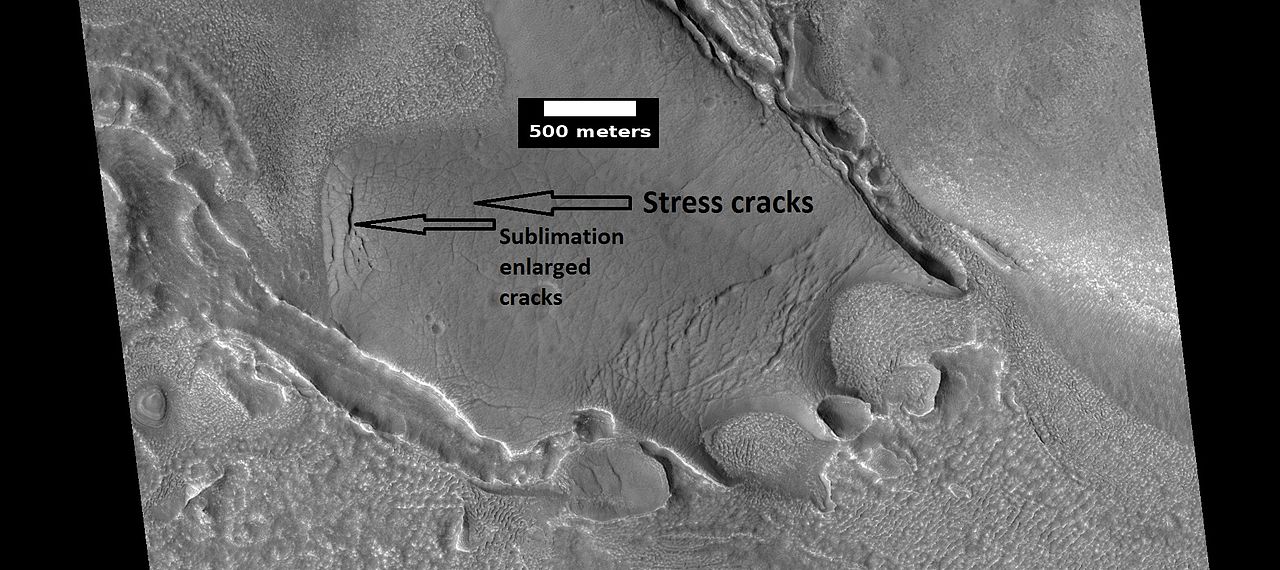 View of stress cracks and larger cracks that have been enlarged by sublimation (ice changing directly into gas) This may be the start of ribbed terrain.
View of stress cracks and larger cracks that have been enlarged by sublimation (ice changing directly into gas) This may be the start of ribbed terrain.
 Close view of terrain caused by ice leaving the ground Box shows size of football field.
Close view of terrain caused by ice leaving the ground Box shows size of football field.
Small cracks often contain small pits and chains of pits; these are thought to be from sublimation of ice in the ground.[57] [58] Large areas of the Martian surface are loaded with ice that is protected by a meters thick layer of dust and other material. However, if cracks appear, a fresh surface will expose ice to the thin atmosphere.[59] [60] In a short time, the ice will disappear into the cold, thin atmosphere in a process called "sublimation." Dry ice behaves in a similar fashion on the Earth. On Mars sublimation has been observed when the Phoenix lander uncovered chunks of ice that disappeared in a few days.[61] [62] In addition, HiRISE has seen fresh craters with ice at the bottom. After a time, HiRISE saw the ice deposit disappear.[63]
The upper plains unit is thought to have fallen from the sky. It drapes various surfaces, since it fell evenly onto all surfaces. As is the case for other mantle deposits, the upper plains unit has layers, is fine-grained, and is ice-rich. It is widespread; it does not seem to have a point source. The surface appearance of some regions of Mars is due to how this unit has degraded. It is a major cause of the surface appearance of lobate debris aprons.[64] The layering of the upper plains mantling unit and other mantling units are believed to be caused by major changes in the planet's climate. Models predict that the obliquity or tilt of the rotational axis has varied from its present 25 degrees to maybe over 80 degrees over geological time. Periods of high tilt will cause the ice in the polar caps to be redistributed and change the amount of dust in the atmosphere.[65] [66] [67]
Dipping layers
Scattered around Mars are features that have been called "dipping layers." They are groups of layers in protected place like inside of craters or against slopes. Several ideas have been advanced for how they were formed.[68] The material that formed them may have dropped from the sky as ice-rich dust.[69] [70] [71] They once covered a wide area, but erosion has since removed most of the material. Another idea for their origin was presented at 55th LPSC (2024) by an international team of researchers. They suggest that the layers are from past ice sheets.[72]
Pits and cracks
Pits in Protonilus Mensae, as seen by HiRISE, under the HiWish program.
Close view of lines of pits Box shows size of football field. Pits may be up to around 50 meters across.
Mesas formed by ground collapse
Polygonal patterned ground
Polygonal, patterned ground is quite common in some regions of Mars.[73] [74] [75] [76] [77] [78] [79] It is commonly believed to be a marker for ice-rich ground because these shapes are common on the Earth in cold regions with lots of ice in the ground.
With the changing seasons, alternate cooling and warming causes the ice-cemented soil to contract and expand. With the right conditions, cracks are made into the hard frozen ground releasing the stresses caused by contraction.[80]
Places on Mars that display polygonal ground may indicate where future colonists can find water ice. Patterned ground forms in a mantle layer, called latitude dependent mantle, that fell from the sky when the climate was different.[81] [82]
Low center polygons
Gullies
Gullies were thought for a time to have been caused by recent flows of liquid water.[83] However, further study suggests they are formed today by chunks of dry ice moving down steep slopes.[84]
Layered features
Dunes
Wide view of a field of dunes
Sand dunes have been found in many places on Mars. The presence of dunes shows that the planet has an atmosphere with wind, for dunes require wind to pile up the sand. Most dunes on Mars are black because of the weathering of the volcanic rock basalt.[85] [86] Black sand can be found on Earth on Hawaii and on some tropical South Pacific islands.[87] Sand is common on Mars due to the old age of the surface that has allowed rocks to erode into sand. Dunes on Mars have been observed to move many meters.[88] [89] In this process, sand moves up the windward side and then falls down the leeward side of the dune, thus caused the dune to go toward the leeward side (or slip face).[90] When images are enlarged, some dunes on Mars display ripples on their surfaces.[91]
Close, color view of dunes, as seen by HiRISE under HiWish program
Ring mold craters
Ring Mold Craters are a kind of Impact crater that looks like a ring mold used in baking. They are believed to be caused by an impact into ice. The ice is covered by a layer of debris. They are found in parts of Mars that have buried ice. Laboratory experiments confirm that impacts into ice result in a "ring mold shape." Impacts into ice, warm the ice, and cause it to flow into the ring mold shape.
Another, later idea, for their formation suggests that the impacting body goes through layers of different densities. Later, erosion could have shaped them. It was thought that ring-mold craters could only exist in areas with large amounts of ground ice. However, with more extensive analysis of larger areas, it was found the ring mold craters are sometimes formed where there is not as much ice underground.[92] [93]
 Ring-mold craters form when an impact goes through to an ice layer. The rebound forms the ring-mold shape, and then dust and debris settle on the top to insulate the ice.
Ring-mold craters form when an impact goes through to an ice layer. The rebound forms the ring-mold shape, and then dust and debris settle on the top to insulate the ice.
In this other idea for ring mold crater formation, an impact crater and the area around it is covered with mantle layers. Next, erosion removes most of the mantle. In the crater, the central section was compressed more due to thick mantle. As a result, it became more resistant to erosion. Only the edges of the mantle were removed by erosion--a plateau results.
Close view of Ring-mold crater, as seen by HiRISE under HiWish program
Volcanoes under ice
There is evidence that volcanoes sometimes erupt under ice, as they do on Earth at times. [94] [95] What seems to happen is that much ice melts, the water escapes, and then the surface cracks and collapses.[96] These exhibit concentric fractures and large pieces of ground that seemed to have been pulled apart. Sites like this may have recently had held liquid water, hence they may be fruitful places to search for evidence of life.[97] [98]
Large group of concentric cracks Location is Ismenius Lacus quadrangle. Cracks were formed by a volcano under ice.[99]
Tilted layers formed when ground collapsed, as seen by HiRISE, under HiWish program
</gallery>
Mesas formed by ground collapse
Fractures forming blocks
In places large fractures break up surfaces. Sometimes straight edges are formed and large cubes are created by the fractures.
Exhumed craters
Some features on Mars seem to be in the process of being uncovered. So, the thought is that they formed, were covered over, and now are being exhumed as material is being taken away by erosion. These features are quite noticeable with craters. When a crater forms, it will destroy what's under it and leave a rim and ejecta. In the example below, only part of the crater is visible. If the crater came after the layered feature, the impact that formed the crater would have removed part of the layered structure.
Mounds
Landslide
Hollows
When ice leaves the ground on Mars, various formations are created. Hollows form when large amounts of ice leave the ground. The ice leaves and then the ground collapses. The ice leaves by sublimation--that is the ice changes directly to a gas--it does not melt.
Other images from Ismenius Lacus quadrangle
Close view of honeycomb shapes and brain terrain, as seen by HiRISE under HiWish program
Ridges
See also
- Dark slope streaks
- Geography of Mars
- High Resolution Imaging Science Experiment (HiRISE)
- HiWish program
- How are features on Mars Named?
- Glaciers on Mars
- Layers on Mars
- Mars Global Surveyor
- Martian features that are signs of water ice
- Martian gullies
- Oceans on Mars
- Periodic climate changes on Mars
- Rivers on Mars
- Sublimation landscapes on Mars
External links
- Martian Ice - Jim Secosky - 16th Annual International Mars Society Convention
- https://www.youtube.com/watch?v=kpnTh3qlObk T. Gordon Wasilewski - Water on Mars - 20th Annual International Mars Society Convention] Describes how to get water from ice in the ground
- https://www.youtube.com/watch?v=PYl3HXpvqhM Kris Zacny Water on Mars - 21st Annual International Mars Society Convention Describes how to get water from ice in the ground]
References
- ↑ Carter | first1 = J. | last2 = Poulet | first2 = F. | last3 = Bibring | first3 = J.-P. | last4 = Murchie | first4 = S. | year = 2010 | title = Detection of Hydrated Silicates in Crustal Outcrops in the Northern Plains of Mars | url = | journal = Science | volume = 328 | issue = 5986| pages = 1682–1686 |
- ↑ Distances calculated using NASA World Wind measuring tool. http://worldwind.arc.nasa.gov/.
- ↑ http://planetarynames.wr.usgs.gov/SearchResults?target=MARS&featureType=Terra,%20terrae
- ↑ USGS Gazetteer of Planetary Nomenclature. Mars. http://planetarynames.wr.usgs.gov/.
- ↑ Blunck, J. 1982. Mars and its Satellites. Exposition Press. Smithtown, N.Y.
- ↑ Parker | first1 = T. J. | last2 = Gorsline | first2 = D. S. | last3 = Saunders | first3 = R. S. | last4 = Pieri | first4 = D. C. | last5 = Schneeberger | first5 = D. M. | year = 1993 | title = Coastal geomorphology of the Martian northern plains | url = | journal = J. Geophys. Res. | volume = 98 | issue = E6| pages = 11061–11078 | doi=10.1029/93je00618 |
- ↑ Fairén | first1 = A. G. |display-authors=etal | year = 2003 | title = Episodic flood inundations of the northern plains of Mars | url = http://eprints.ucm.es/10431/1/9-Marte_3.pdf%7C journal = Icarus | volume = 165 | issue = 1| pages = 53–67 |
- ↑ Head | first1 = J. W. |display-authors=etal | year = 1999 | title = Possible ancient oceans on Mars: Evidence from Mars Orbiter Laser Altimeter data | url = | journal = Science | volume = 286 | issue = 5447| pages = 2134–2137 | doi=10.1126/science.286.5447.2134| pmid = 10591640 |
- ↑ Parker, T. J., Saunders, R. S. & Schneeberger, D. M. Transitional morphology in west Deuteronilus Mensae, Mars: Implications for modification of the lowland/upland boundary" Icarus 1989; 82, 111–145
- ↑ Carr | first1 = M. H. | last2 = Head | first2 = J. W. | year = 2003 | title = Oceans on Mars: An assessment of the observational evidence and possible fate | url = | journal = J. Geophys. Res. | volume = 108 | issue = E5| page = 5042 |
- ↑ Kreslavsky | first1 = M. A. | last2 = Head | first2 = J. W. | year = 2002| title = Fate of outflow channel effluent in the northern lowlands of Mars: The Vastitas Borealis Formation as a sublimation residue from frozen ponded bodies of water | url = | journal = J. Geophys. Res. | volume = 107 | issue = E12| page = 5121 |
- ↑ Clifford, S. M. & Parker, T. J. The evolution of the martian hydrosphere: Implications for the fate of a primordial ocean and the current state of the northern plains" Icarus 2001; 154, 40–79
- ↑ https://www.convertunits.com/from/metre/to/story
- ↑ Ancient Tsunami Evidence on Mars Reveals Life Potential |date=May 20, 2016 |url=http://astrobiology.com/2016/05/ancient-tsunami-evidence-on-mars-reveals-life-potential.html
- ↑ Rodriguez | first1 = J. |display-authors=etal | year = 2016 | title = Tsunami waves extensively resurfaced the shorelines of an early Martian ocean | url = | journal = Scientific Reports | volume = 6 | issue = | page = 25106 | doi=10.1038/srep25106| pmid = 27196957 | pmc = 4872529 |
- ↑ | doi=10.1038/srep25106| pmid=27196957| pmc=4872529| title=Tsunami waves extensively resurfaced the shorelines of an early Martian ocean| journal=Scientific Reports| volume=6| pages=25106| year=2016| last1=Rodriguez| first1=J. Alexis P.| last2=Fairén| first2=Alberto G.| last3=Tanaka| first3=Kenneth L.| last4=Zarroca| first4=Mario| last5=Linares| first5=Rogelio| last6=Platz| first6=Thomas| last7=Komatsu| first7=Goro| last8=Miyamoto| first8=Hideaki| last9=Kargel| first9=Jeffrey S.| last10=Yan| first10=Jianguo| last11=Gulick| first11=Virginia| last12=Higuchi| first12=Kana| last13=Baker| first13=Victor R.| last14=Glines| first14=Natalie
- ↑ Cornell University. "Ancient tsunami evidence on Mars reveals life potential." ScienceDaily. ScienceDaily, 19 May 2016. https://www.sciencedaily.com/releases/2016/05/160519101756.htm.
- ↑ http://www.uahirise.org/ESP_039997_2170
- ↑ U.S. department of the Interior U.S. Geological Survey, Topographic Map of the Eastern Region of Mars M 15M 0/270 2AT, 1991
- ↑ http://space.com/scienceastronomy/090514--mars-rivers.html
- ↑ https://en.wikipedia.org/wiki/Micrometre
- ↑ doi=10.1002/2017GL073821 | volume=44 | issue=11 | title=Extensive Amazonian-aged fluvial channels on Mars: Evaluating the role of Lyot crater in their formation | journal=Geophysical Research Letters | pages=5336–5344 | last1 = Weiss | first1 = David K.|
- ↑ Weiss, D., et al. 2017. Extensive Amazonian-aged fluvial channels on Mars: Evaluating the role of Lyot crater in their formation. Geophysical Research Letters: 44, doi:10.1002/2017GL073821.
- ↑ http://spaceref.com/mars/hot-rocks-led-to-relatively-recent-water-carved-valleys-on-mars.html
- ↑ http://www.lpi.usra.edu/publications/slidesets/stones/
- ↑ Hugh H. Kieffer|title=Mars|url=https://books.google.com/books?id=NoDvAAAAMAAJ%7Caccessdate=7 March 2011|date=1992|publisher=University of Arizona Press|isbn=978-0-8165-1257-7}}
- ↑ http://www.uahirise.org/epo/nuggets/expanded-secondary.pdf
- ↑ Viola, D., et al. 2014. EXPANDED CRATERS IN ARCADIA PLANITIA: EVIDENCE FOR >20 MYR OLD SUBSURFACE ICE. Eighth International Conference on Mars (2014). 1022pdf.
- ↑ Irwin III, R. et al. 2005. An intense terminal epoch of widespread fluvial activity on early Mars: 2. Increased runoff and paleolake development. Journal of Geophysical Research: 10. E12S15
- ↑ Sharp, R. 1973. Mars Fretted and chaotic terrains. J. Geophys. Res.: 78. 4073–4083
- ↑ http://www.lpi.usra.edu/meetings/lpsc2000/pdf/1053.pdf
- ↑ Plaut, J. et al. 2008. Radar Evidence for Ice in Lobate Debris Aprons in the Mid-Northern Latitudes of Mars. Lunar and Planetary Science XXXIX. 2290.pdf
- ↑ Plaut | first1 = J. | last2 = Safaeinili | first2 = A. | last3 = Holt | first3 = J. | last4 = Phillips | first4 = R. | last5 = Head | first5 = J. | last6 = Seu | first6 = R. | last7 = Putzig | first7 = N. | last8 = Frigeri | first8 = A. | year = 2009 | title = Radar evidence for ice in lobate debris aprons in the midnorthern latitudes of Mars | url = https://semanticscholar.org/paper/f6b94761e6a276ce6894374ae9bea88fdc3e5e19%7C journal = Geophys. Res. Lett. | volume = 36| issue = 2| pages = n/a |
- ↑ Hugh H. Kieffer (1992). Mars. University of Arizona Press. ISBN 978-0-8165-1257-7
- ↑ Plaut, J. et al. 2008. Radar Evidence for Ice in Lobate Debris Aprons in the Mid-Northern Latitudes of Mars. Lunar and Planetary Science XXXIX. 2290.pdf
- ↑ http://www.esa.int/SPECIALS/Mars_Express/SEMBS5V681F_0.html
- ↑ http://news.discovery.com/space/mars-ice-sheet-climate.html
- ↑ Madeleine, J. et al. 2007. Exploring the northern mid-latitude glaciation with a general circulation model. In: Seventh International Conference on Mars. Abstract 3096.
- ↑ http://www.uahirise.org/ESP_018857_2225
- ↑ http://hirise.lpl.arizona.edu/PSP_009719_2230
- ↑ Hecht | first1 = M | year = 2002 | title = Metastability of water on Mars | url = | journal = Icarus | volume = 156 | issue = 2| pages = 373–386 | doi=10.1006/icar.2001.6794 |
- ↑ Mustard | first1 = J. |display-authors=etal | year = 2001 | title = Evidence for recent climate change on Mars from the identification of youthful near-surface ground ice | url = | journal = Nature | volume = 412 | issue = 6845| pages = 411–414 |
- ↑ Pollack | first1 = J. | last2 = Colburn | first2 = D. | last3 = Flaser | first3 = F. | last4 = Kahn | first4 = R. | last5 = Carson | first5 = C. | last6 = Pidek | first6 = D. | year = 1979 | title = Properties and effects of dust suspended in the martian atmosphere | url = | journal = J. Geophys. Res. | volume = 84 | issue = | pages = 2929–2945 | doi=10.1029/jb084ib06p02929 |
- ↑ Touma | first1 = J. | last2 = Wisdom | first2 = J. | year = 1993 | title = The Chaotic Obliquity of Mars | url = | journal = Science | volume = 259 | issue = 5099| pages = 1294–1297 |
- ↑ Laskar | first1 = J. | last2 = Correia | first2 = A. | last3 = Gastineau | first3 = M. | last4 = Joutel | first4 = F. | last5 = Levrard | first5 = B. | last6 = Robutel | first6 = P. | year = 2004 | title = Long term evolution and chaotic diffusion of the insolation quantities of Mars | url = | journal = Icarus | volume = 170 | issue = 2| pages = 343–364 |
- ↑ Levy | first1 = J. | last2 = Head | first2 = J. | last3 = Marchant | first3 = D. | last4 = Kowalewski | first4 = D. | year = 2008 | title = Identification of sublimation-type thermal contraction crack polygons at the proposed NASA Phoenix landing site: Implications for substrate properties and climate-driven morphological evolution | url = | journal = Geophys. Res. Lett. | volume = 35| issue = 4| pages = L04202 | doi = 10.1029/2007GL032813 |
- ↑ Levy | first1 = J. | last2 = Head | first2 = J. | last3 = Marchant | first3 = D. | year = 2009a | title = Thermal contraction crack polygons on Mars: Classification, distribution, and climate implications from HiRISE observations | url = | journal = J. Geophys. Res. | volume = 114| issue = E1| pages = E01007 | doi = 10.1029/2008JE003273 |
- ↑ Hauber, E., D. Reiss, M. Ulrich, F. Preusker, F. Trauthan, M. Zanetti, H. Hiesinger, R. Jaumann, L. Johansson, A. Johnsson, S. Van Gaselt, M. Olvmo. 2011. Landscape evolution in Martian mid-latitude regions: insights from analogous periglacial landforms in Svalbard. In: Balme, M., A. Bargery, C. Gallagher, S. Guta (eds). Martian Geomorphology. Geological Society, London. Special Publications: 356. 111–131
- ↑ Laskar, J.; Correia, A.; Gastineau, M.; Joutel, F.; Levrard, B.; Robutel, P. (2004). "Long term evolution and chaotic diffusion of the insolation quantities of Mars". Icarus. 170 (2): 343–364.
- ↑ Mellon | first1 = M. | last2 = Jakosky | first2 = B. | year = 1995 | title = The distribution and behavior of Martian ground ice during past and present epochs | url = https://semanticscholar.org/paper/815bfd93bdb19325e03e08556d145fa470112e4e%7C journal = J. Geophys. Res. | volume = 100 | issue = E6| pages = 11781–11799 |
- ↑ Schorghofer | first1 = N | year = 2007 | title = Dynamics of ice ages on Mars | url = | journal = Nature | volume = 449 | issue = 7159| pages = 192–194 | doi=10.1038/nature06082| pmid = 17851518 |
- ↑ Madeleine, J., F. Forget, J. Head, B. Levrard, F. Montmessin. 2007. Exploring the northern mid-latitude glaciation with a general circulation model. In: Seventh International Conference on Mars. Abstract 3096.
- ↑ http://www.uahirise.org/ESP_048897_2125
- ↑ Carr | first1 = M | year = 2001 | title = Mars Global Surveyor observations of martian fretted terrain | url = | journal = J. Geophys. Res. | volume = 106 | issue = E10| pages = 23571–23593 | doi=10.1029/2000je001316 |
- ↑ http://citeseerx.ist.psu.edu/viewdoc/download?doi=10.1.1.722.2437&rep=rep1&type=pdf
- ↑ Baker, D and J. Head. 2015. Extensive Middle Amazonian mantling of debris aprons and plains in Deuteronilus Mensae, Mars: Implications for the record of mid-latitude glaciation. Icarus: 260, 269-288.
- ↑ Morgenstern, A., et al. 2007
- ↑ Baker, D., J. Head. 2015. Extensive Middle Amazonian mantling of debris aprons and plains in Deuteronilus Mensae, Mars: Implication for the record of mid-latitude glaciation. Icarus: 260, 269–288.
- ↑ Mangold | first1 = N | year = 2003 | title = Geomorphic analysis of lobate debris aprons on Mars at Mars Orbiter Camera scale: Evidence for ice sublimation initiated by fractures | url = | journal = J. Geophys. Res. | volume = 108 | issue = E4| page = 8021 | doi=10.1029/2002je001885
- ↑ Levy, J. et al. 2009. Concentric
- ↑ http://www.nasa.gov/mission_pages/phoenix/news/phoenix-20080619.html Bright Chunks at Phoenix Lander's Mars Site Must Have Been Ice – Official NASA press release (19.06.2008)
- ↑ http://www.nasa.gov/mission_pages/phoenix/news/phoenix-20080619.html
- ↑ Byrne | first1 = S. |display-authors=etal | year = 2009 | title = Distribution of Mid-Latitude Ground Ice on Mars from New Impact Craters | url = | journal = Science | volume = 329 | issue = 5948| pages = 1674–1676 | doi = 10.1126/science.1175307 |
- ↑ Baker, D., J. Head. 2015. Extensive Middle Amazonian mantling of debris aprons and plains in Deuteronilus Mensae, Mars: Implication for the record of mid-latitude glaciation. Icarus: 260, 269–288.
- ↑ Head, J. et al. 2003.
- ↑ Madeleine, et al. 2014.
- ↑ Schon |display-authors=etal | year = 2009 | title = A recent ice age on Mars: Evidence for climate oscillations from regional layering in mid-latitude mantling deposits | url = | journal = Geophys. Res. Lett. | volume = 36 | issue = 15| page = L15202 | bibcode = 2009GeoRL..3615202S|
- ↑ R.J. Soare et al. 2013. Sub-kilometre (intra-crater) mounds in Utopia Planitia, Mars: character, occurrence and possible formation hypotheses, Icarus, 225, 982–991.
- ↑ Morgenstern, A,, et al. 2007. Deposition and degradation of a volatile-rich layer in Utopia Planitia and implications for climate history on Mars. Journal of Geophysical Research Planets. Volume 112. IssueE6
- ↑ Carr, M. 2001. "Mars Global Surveyor observations of martian fretted terrain". J. Geophys. Res. 106, 23571-23593.
- ↑ Baker, D., J. Head. 2015. "Extensive Middle Amazonian mantling of debris aprons and plains in Deuteronilus Mensae, Mars: Implication for the record of mid-latitude glaciation". Icarus: 260, 269-288
- ↑ Blanc, E., et al. 2024. ORIGIN OF WIDESPREAD LAYERED DEPOSITS ASSOCIATED WITH MARTIAN DEBRIS COVERED GLACIERS. 55th LPSC (2024). 1466.pdf
- ↑ http://www.diss.fu-berlin.de/diss/servlets/MCRFileNodeServlet/FUDISS_derivate_000000003198/16_ColdClimateLandforms-13-utopia.pdf?hosts=
- ↑ Kostama | first1 = V.-P. | last2 = Kreslavsky | first2 = Head | year = 2006 | title = Recent high-latitude icy mantle in the northern plains of Mars: Characteristics and ages of emplacement | url = | journal = Geophys. Res. Lett. | volume = 33 | issue = 11| page = L11201 |
- ↑ Malin | first1 = M. | last2 = Edgett | first2 = K. | year = 2001 | title = Mars Global Surveyor Mars Orbiter Camera: Interplanetary cruise through primary mission | url = https://semanticscholar.org/paper/ad350109a111b6425140583455c222a0529f45c6%7C journal = J. Geophys. Res. | volume = 106 | issue = E10| pages = 23429–23540 |
- ↑ Milliken | first1 = R. |display-authors=etal | year = 2003 | title = Viscous flow features on the surface of Mars: Observations from high-resolution Mars Orbiter Camera (MOC) images | url = https://semanticscholar.org/paper/a822f14644d2294b948e101be2f294ac33b57ec3%7C journal = J. Geophys. Res. | volume = 108 | issue = E6| page = E6 | doi = 10.1029/2002JE002005 |
- ↑ Mangold | first1 = N | year = 2005 | title = High latitude patterned grounds on Mars: Classification, distribution and climatic control | url = | journal = Icarus | volume = 174 | issue = 2| pages = 336–359 | doi=10.1016/j.icarus.2004.07.030 |
- ↑ Kreslavsky | first1 = M. | last2 = Head | first2 = J. | year = 2000 | title = Kilometer-scale roughness on Mars: Results from MOLA data analysis | url = | journal = J. Geophys. Res. | volume = 105 | issue = E11| pages = 26695–26712 | doi=10.1029/2000je001259 |
- ↑ Seibert | first1 = N. | last2 = Kargel | first2 = J. | year = 2001 | title = Small-scale martian polygonal terrain: Implications or liquid surface water | url = | journal = Geophys. Res. Lett. | volume = 28 | issue = 5| pages = 899–902
- ↑ https://www.uahirise.org/ESP_066782_1110
- ↑ Kreslavsky, M.A., Head, J.W., 2002. High-latitude Recent Surface Mantle on Mars: New Results from MOLA and MOC. European Geophysical Society XXVII, Nice.
- ↑ Head | first1 = J.W. | last2 = Mustard | first2 = J.F. | last3 = Kreslavsky | first3 = M.A. | last4 = Milliken | first4 = R.E. | last5 = Marchant | first5 = D.R. | year = 2003 | title = Recent ice ages on Mars | url = | journal = Nature | volume = 426 | issue = 6968| pages = 797–802 | doi=10.1038/nature02114| pmid = 14685228 |
- ↑ https://www.uahirise.org/hipod/ESP_014074_1445
- ↑ Harrington |first=J.D. |last2=Webster |first2=Guy |title=RELEASE 14-191 – NASA Spacecraft Observes Further Evidence of Dry Ice Gullies on Mars |url=http://www.nasa.gov/press/2014/july/nasa-spacecraft-observes-further-evidence-of-dry-ice-gullies-on-mars |date=July 10, 2014 |work=NASA |accessdate=July 10, 2014
- ↑ http://hirise.lpl.arizona.edu/ESP_016459_1830
- ↑ Michael H. Carr|title=The surface of Mars|url=https://books.google.com/books?id=uLHlJ6sjohwC%7Caccessdate=21 March 2011|year=2006|publisher=Cambridge University Press|isbn=978-0-521-87201-0
- ↑ https://www.desertusa.com/desert-activity/sand-dune-wind1.html
- ↑ https://www.youtube.com/watch?v=ur_TeOs3S64
- ↑ https://uanews.arizona.edu/story/the-flowing-sands-of-mars
- ↑ Namowitz, S., Stone, D. 1975. earth science the world we live in. American Book Company. New York.
- ↑ https://www.jpl.nasa.gov/news/news.php?feature=6551
- ↑ https://www-sciencedirect-com.wikipedialibrary.idm.oclc.org/science/article/pii/S0019103518301532
- ↑ Baker, D. and L. Carter. 2019. Probing supraglacial debris on Mars 2: Crater morphology. Icarus. Volume 319. Pages 264-280
- ↑ https://www.uahirise.org/ESP_071541_2200
- ↑ Levy, J. et al. 2017. Candidate volcanic and impact-induced ice depressions on Mars. Icarus. Volume 285. Pages 185-194
- ↑ Smellie, J., B. Edwards. 2016. Glaciovolcanism on Earth and Mars. Cambridge University Press.
- ↑ Levy, J. 2017">Levy, J., et al. 2017. Candidate volcanic and impact-induced ice depressions on Mars. Icarus: 285, 185–194.
- ↑ University of Texas at Austin. "A funnel on Mars could be a place to look for life." ScienceDaily. ScienceDaily, 10 November 2016. <https://www.sciencedaily.com/releases/2016/11/161110125408.htm>.
- ↑ Levy, J., et al. 2017. Candidate volcanic and impact-induced ice depressions on Mars. Icarus: 285, 185–194.
